‘The Wild Goose Club shall consist of 15 Ganders in Full Plumage; each an Officer with High Rank & Large Pay’
Article 1 of The Wild Goose Club By-Laws
*
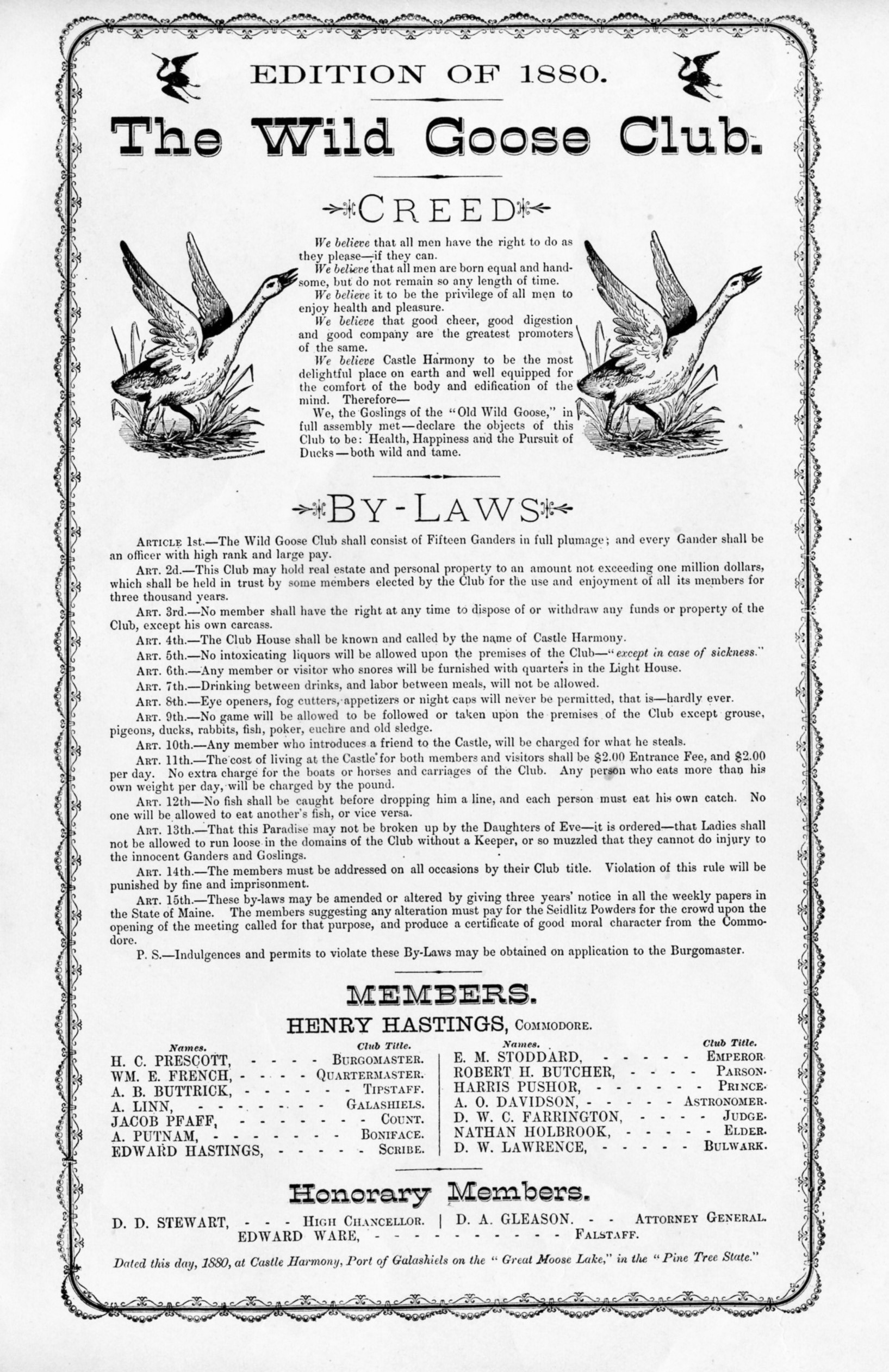
Wild Goose Club Creed & Bylaws – 1880
*
Our thanks to Brenda Seekins, author & Hartland Historical Society Member, for sharing many of the Castle Harmony & Commodore Club photos & stories included below which she gathered while researching her 2006 book, ‘Around Great Moose Lake’. These photos and many other items had been left behind by Wild Goose Club Members after the club disbanded in the early 1930s. They were recognized as important historical pieces by Castle Harmony’s future owners, Theodore B. Hayward and his wife Dorothy Boehmler of Pennsylvania, as well as its next owners, William Trauth, Sr and his wife Lorna of New York.
Lorna Trauth later noted that when they first visited the property in 1955, “The Haywards had made every attempt to preserve the Club as it had been in the former days. The pot-bellied stoves, fireman’s beds, old light fixtures, elaborate bar, butter churn, leather bound books on the library shelves and other memorabilia of bygone days were still in evidence; only the kitchen had been updated. They pointed out the original poker table in the Library, the handsome gilt framed oil portraits of the members of the CIub and the many framed photographs and documents in the dining room, where once the original ‘Ganders’ were served their sumptuous meals.”
We are eternally grateful to the Hayward Family for caring for these wonderful photos and items and passing them along to the Trauth Family who in turn equally cared for them and graciously shared them with Brenda so this incredible story may be preserved and told to all. Further information of the Trauth’s story at Castle Harmony may be found on our dedicated Wild Goose Club for Boys page.
Many of the additional historical details included in our presentation of The Wild Goose Club’s history are compiled from a 1954 Lewiston Journal article with Mr. & Mrs. Hayward and a 1956 Little Talks Magazine article with Mr. & Mrs. Trauth. Both complete articles may be seen near the bottom of this page.
*
~ The Madawaska Club ~
The story of The Wild Goose Club at Castle Harmony began in 1862 when a group of fifteen wealthy gentlemen from the greater Boston area organized “The Madawaska Club” originally based in Pittsfield, Maine. The founder and leading spirit of the club was Henry Hastings (1818-1887) of Medford, Massachusetts. Mr. Hastings was already known at the time as “The Commodore”; a complimentary title he had previously received from merchants as a major shipowner which was carried forth by club members as the presidential title of the club.
Their objective was outdoor recreation, especially fishing, duck hunting, and the snaring of wild pigeons. Pittsfield was selected as their first headquarters in part because it was the largest town in an area famous for its annual fall flights of wild pigeons in the middle of the 19th century including nearby Madawaska Pond in Palmyra, the club’s likely namesake. Pittsfield was also directly accessible from Boston via Maine Central Railroad and had a well known hotel, The Lancey House, where club members initially stayed and dined.
The organization soon took over a building which stood in an open field near the hotel. They converted the building into a club house with a living room and kitchen on the lower floor and one big dormitory room with cots occupying the second floor. They would continue to get their main meals at The Lancey House. Club members chartered a private sleeping car from the railroad and usually make the trip to Pittsfield in July.
A few members who were retired from active business remained all summer and well into the fall while others came for shorter visits. All put in a lot of time fishing and when September came, duck hunting and pigeon snaring were the principal sports.
While sport was their principle goal during these stays, they were also a jolly group of men who enjoyed all the pleasures of their time and adventures in Maine. And they got thirsty. On August 20, 1865 when their club house was still at Pittsfield, The Commodore sent a letter to General Samuel Lawrence in Medford, Massachusetts in which he wrote, “Seven of us are languishing for that distilled aqua which was originally discovered by one of your ancestors, famous for its strengthening and invigorating qualities, called Old Medford Rum. I will forgive you all your faults if you will ship by the Eastern Express Company one five gallon keg of the oldest vintage to the Madawaska Club, Pittsfield, Maine.”
General Lawrence replied, “Dear General Hastings. Per your serious appeal for the seven sons of Medford desperately dry. Since I cannot accept your invitation and come personally to your relief, I will content myself by sending five gallons of proxy.”
*
~ Castle Harmony ~
The first Madawaska Club House in Pittsfield put them near prime hunting and fishing areas, however its location near the populated downtown section of Pittsfield still wasn’t the ideal location for these adventurous gentlemen seeking not only wilderness adventures but also a secluded location to retreat to after for their boisterous entertainment purposes.
That all changed in 1866 with a chance meeting on a steam ship returning from England between Commodore Henry Hastings and Hartland resident and businessman Archibald Linn (1818-1889), owner of the Linn Woolen Mill. The two gentlemen eventually discussed the idea of building a dedicated lodge for the club on Great Moose Lake where Mr. Linn had a large property on the Harmony side of the lake which he highly praised for its ideal location for hunting and fishing and, undoubtedly as important to the members, its isolation from the masses.
Later that same year in September, the newest member of the Madawaska Club, Archibald Linn, led an expedition with Mr. Hastings and 8 other club members. The group traveled by steamboat up the Sebasticook River from Hartland Village into Great Moose Lake then onto the Main Stream inlet on the Harmony shoreline of the lake. There they scouted Linn’s 900+ acre property and staked out an ideal location for a new club lodge along the shores of Main Stream. It is currently unknown if Mr. Linn sold or donated the property but it was all eventually deeded to the club on September 30, 1871. Additional land was later purchased bringing the total club holdings to about 1200 acres.
After presenting the results of their scouting mission at Linn’s Main Stream property to the rest of the club members for final acceptance, plans soon began to develop the property over the next few years and in 1872 the new Madawaska Club Main Lodge was completed and ready for their use. They named the new lodge “Castle Harmony”; doubly appropriate because it lay in the town of Harmony and the word applied to their group of congenial fellows getting recreation together. They would nickname the cove at Main Stream where Castle Harmony was located as “Port of Galashiels” in honor of the town in Scotland where Linn had lived after he married and started his family.
*
Note: These 2 undated, unnamed photos below come to us from the collection of one of the Archibald Linn Family descendants. We have not yet been able to confirm without doubt, but we believe they may be the oldest known photos of the original Castle Harmony Main Lodge. Many of the features seen in these photos resemble its unique facade and porch before future building and shoreline renovations were completed.
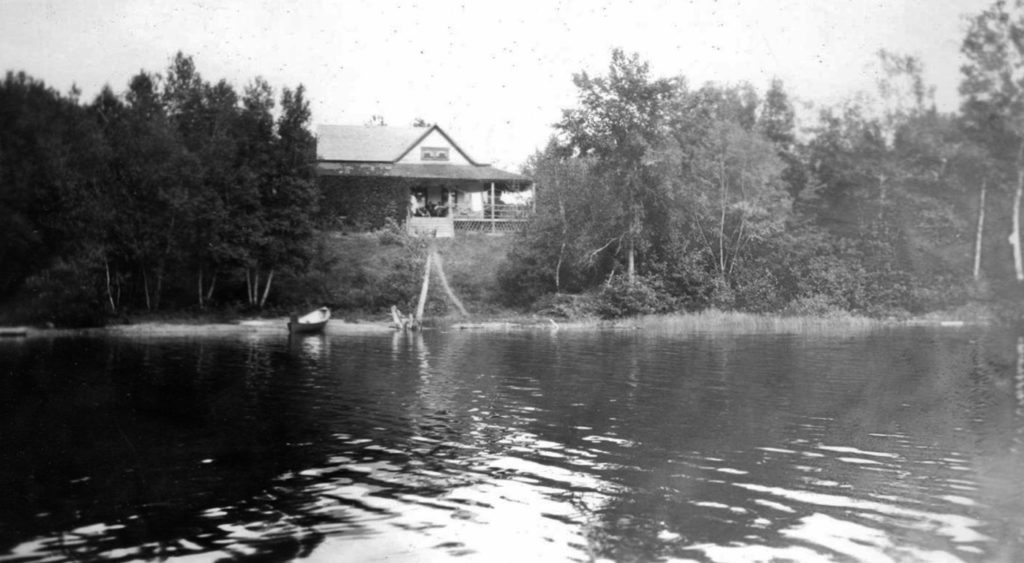
Original (?) Castle Harmony Main Lodge
(Photo courtesy of Joan Joy Tibbetts)
*
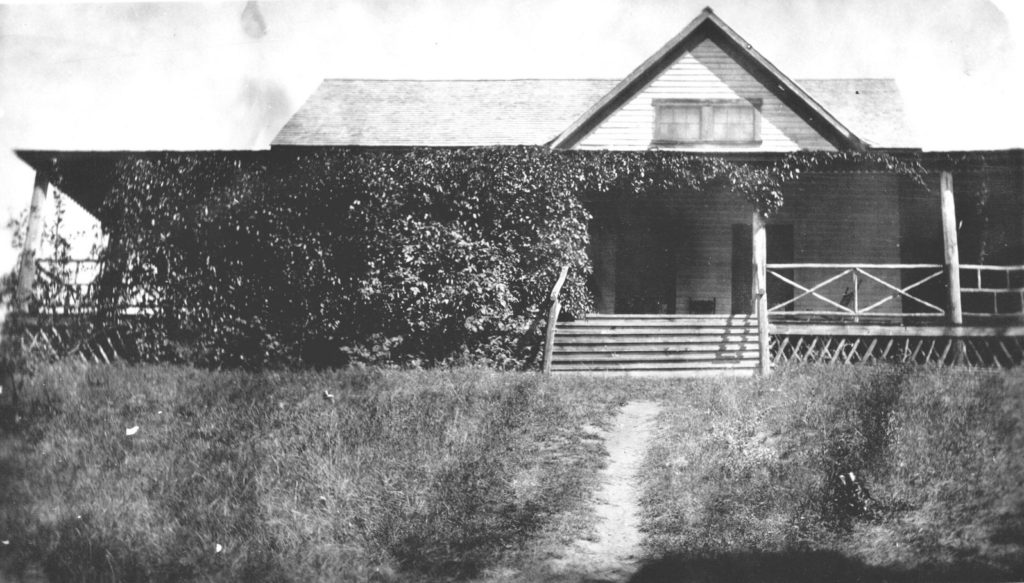
Original (?) Castle Harmony Main Lodge
(Photo courtesy of Joan Joy Tibbetts)
*
~ The Wild Goose Club ~
Legend holds that during the 1866 expedition to Mr. Linn’s huge, heavily wooded 900 acre+ property on Great Moose Lake, one of the club members commented it to be a “Wild Goose Trip”; a reference which seemingly stuck in member’s minds a few years later.
On December 10, 1873, members of The Madawaska Club met in Boston and voted to change their name to The Wild Goose Club with Castle Harmony designated as their new club headquarters. Over the years of its existence, members and guests of The Wild Goose Club would include hundreds of prominent politicians, decorated military leaders, influential businessmen, and eventually women, who traveled to the vaunted grounds at Castle Harmony for hunting, fishing and plenty of entertainment.
*
Despite their affluential standings in their native homelands, Wild Goose Club Members maintained a sense of humor at Castle Harmony.
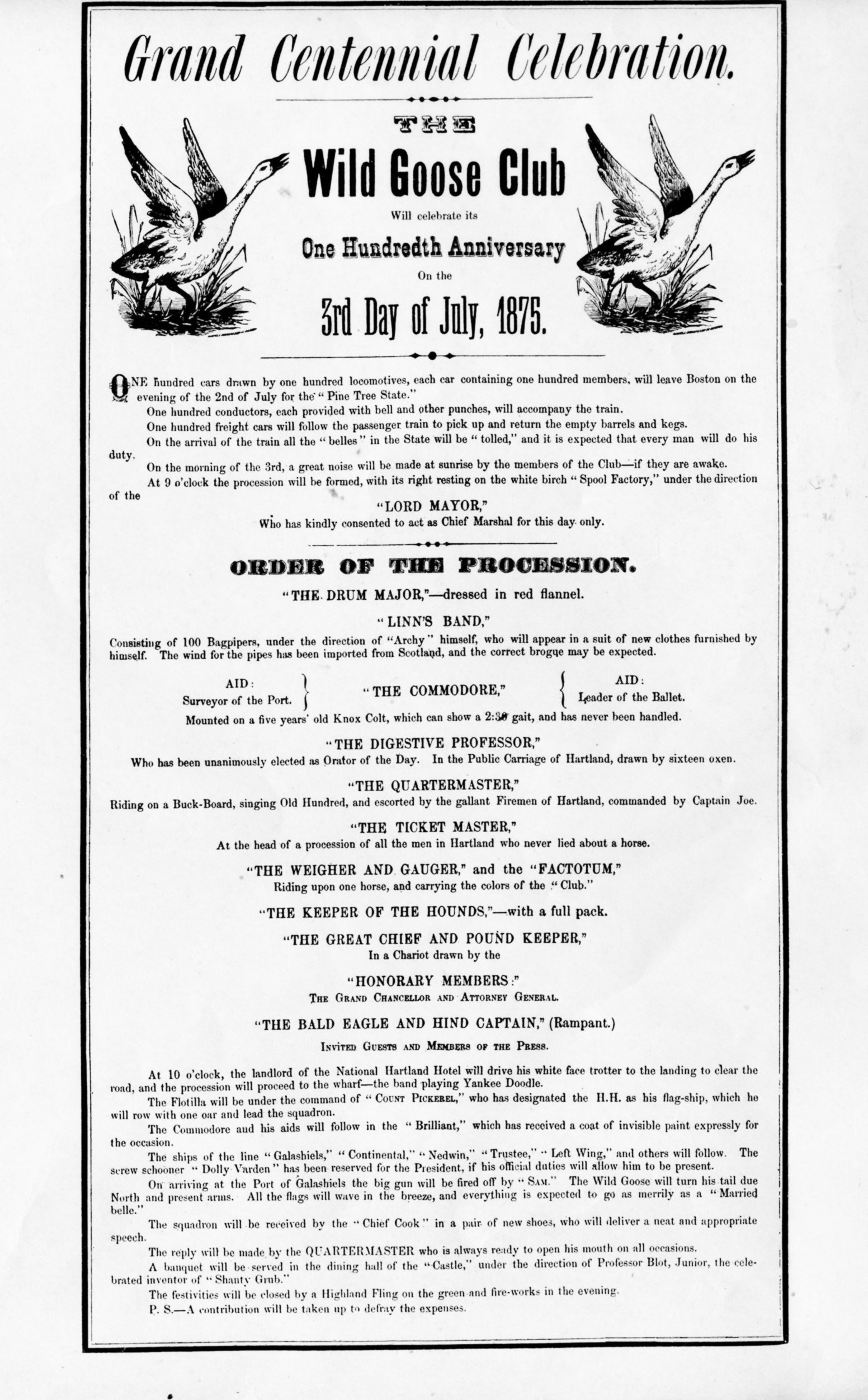
Wild Goose Club Parade Agenda – 1875
*
An 1886 article provides numerous tidbits during a private excursion attended by the author and several local Hartland businessmen.
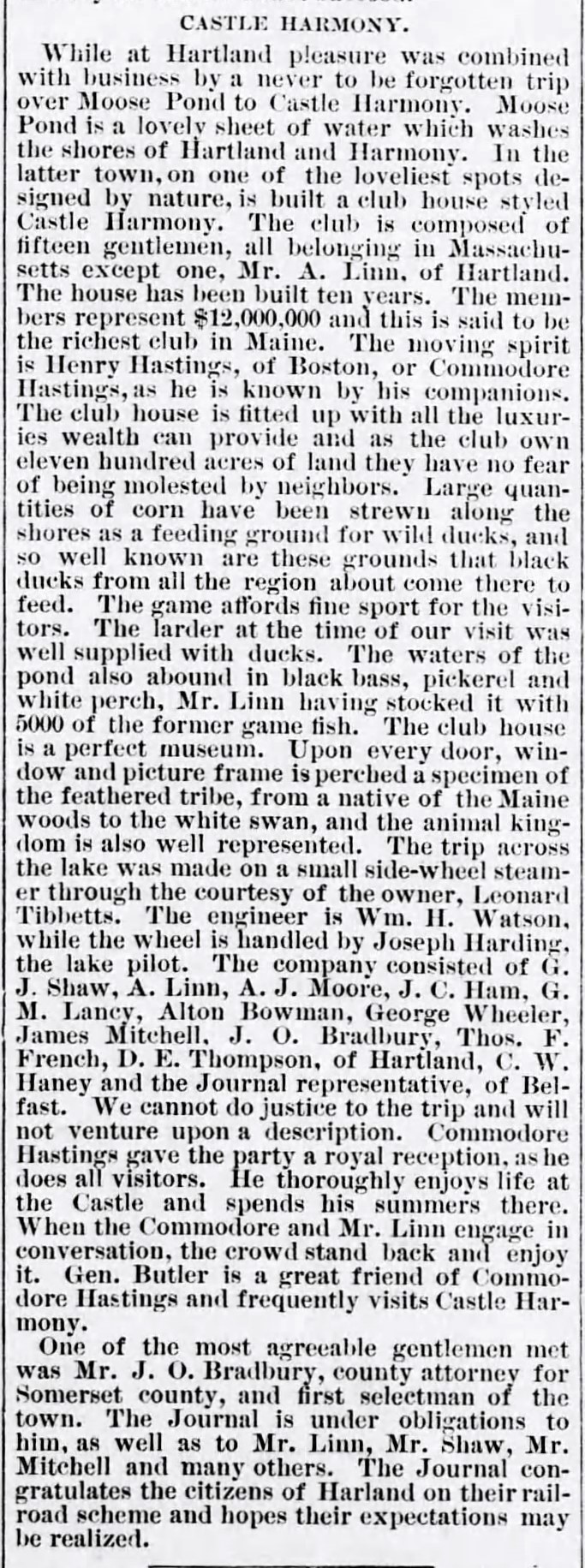
Republication Journal of Belfast – September 30, 1886
*
Posing for a group photo in front of the Castle Harmony Clubhouse would become a long standing tradition for Wild Goose Club members & guest over the years. While fortunately most of later dated photos we’ve included identified the people in these candid shots, this early photo likely taken in the mid-1880s did not include any names.
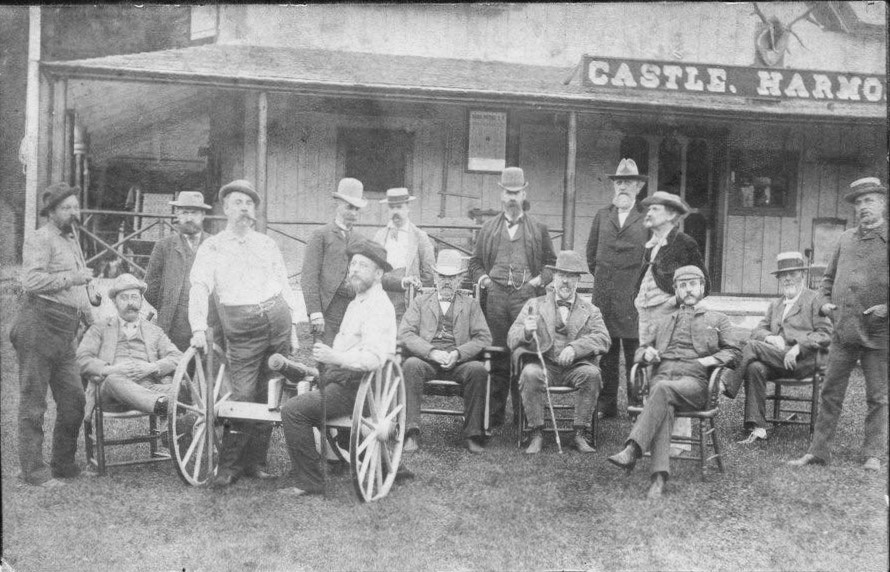
An unidentified group of Wild Goose Club Members at Castle Harmony with their cannon
We have been informed by his Great-Great-Grandson Doug Thomson, the gentleman standing to the far right is Alexis Torrey.
*
Future renovations to the original Castle Harmony Lodge included the addition of dormers and major landscape work down to the shoreline.
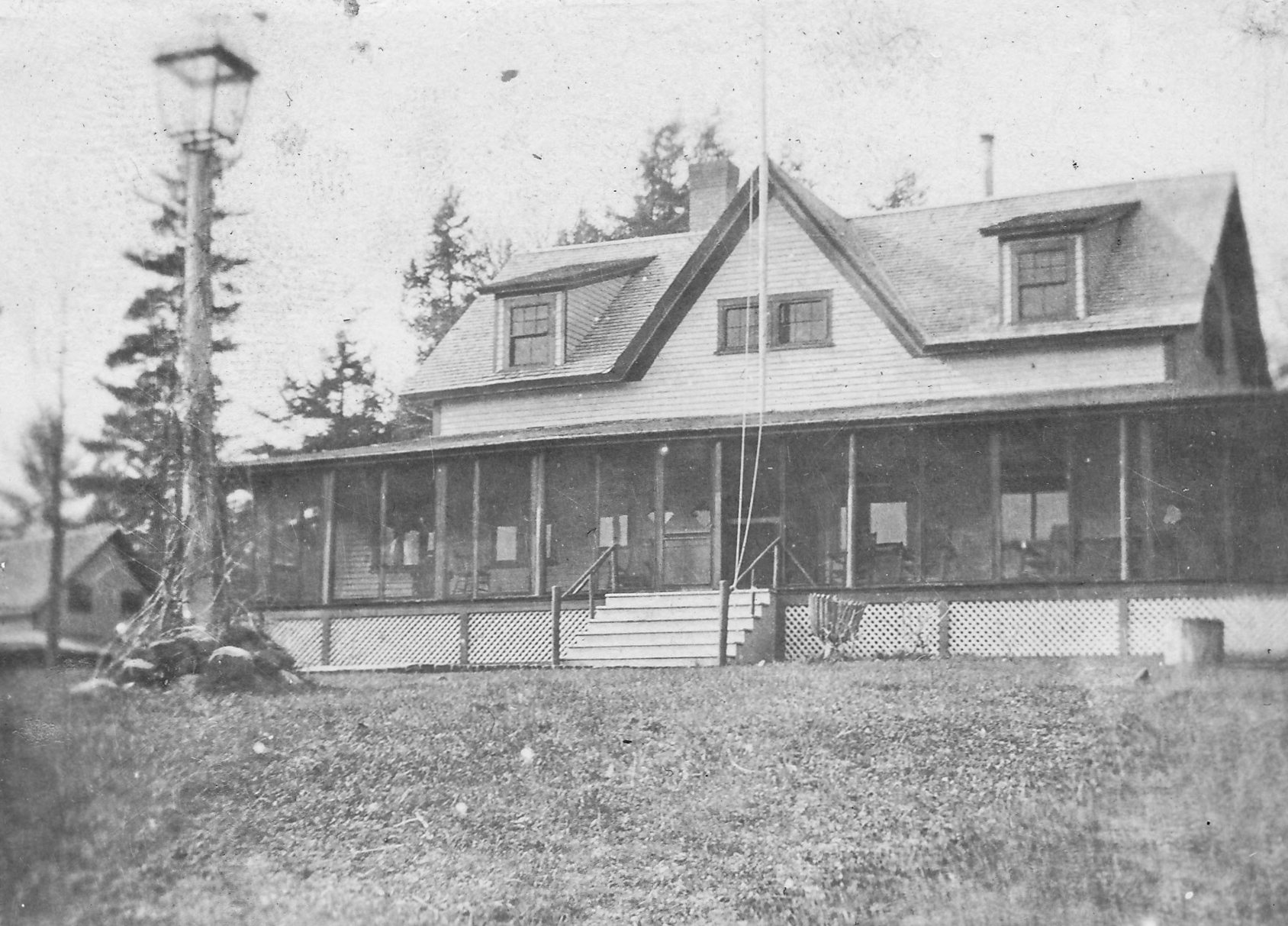
Castle Harmony Main Lodge
*
For the first dozen or so years, getting to the new club house was itself a bit of an adventure. While hardly roughing it, compared to most travelers at the time, Wild Goose Club members and guests first took the long train ride, albeit typically in a comfortable private rail car, from Boston to the Maine Central Railroad Depot in Pittsfield. They then rode in horse drawn carriages the 8 miles from Pittsfield to the Upper Dam Boat Launch in Hartland Village. From the launch, private or rented boats shuttled them up the Sebasticook River and across Great Moose Lake the last few miles to Castle Harmony.
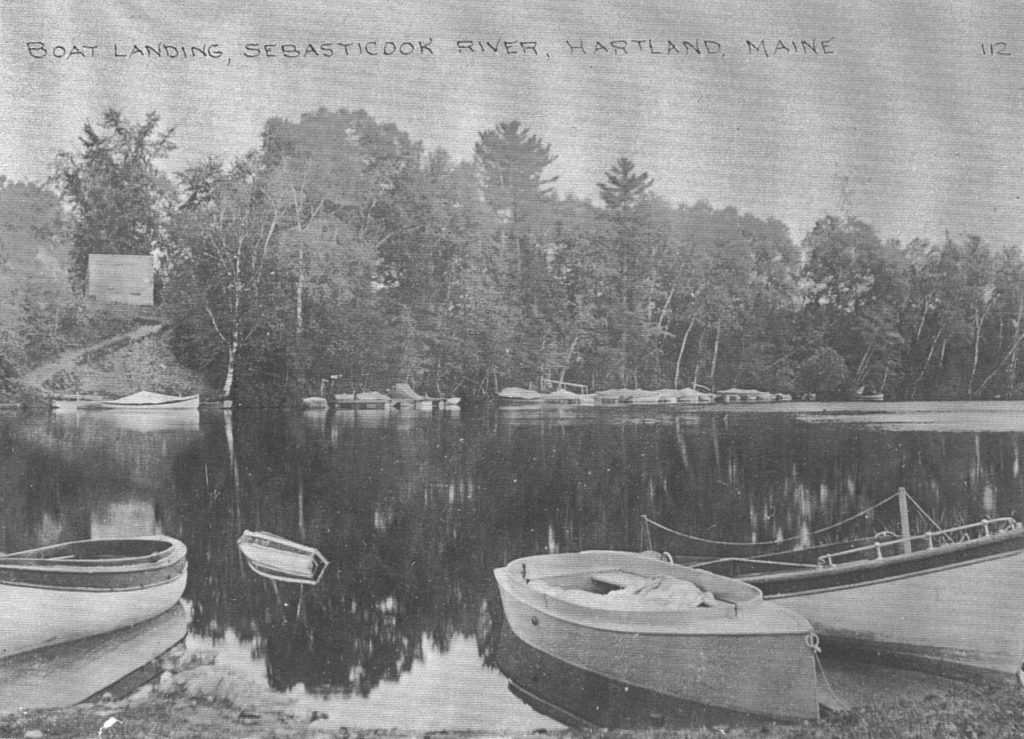
Sebasticook River Boat Landing above the Upper Dam
*
Built by 1880, The Wild Goose Club’s first private lighthouse was likely a welcome sight to weary travelers as their private chartered boats neared the Main Stream entrance from Great Moose Lake to reach Castle Harmony. Members and guests often arrived late at night so the wooden framed lighthouse would be lit with lanterns to guide them into the inlet.
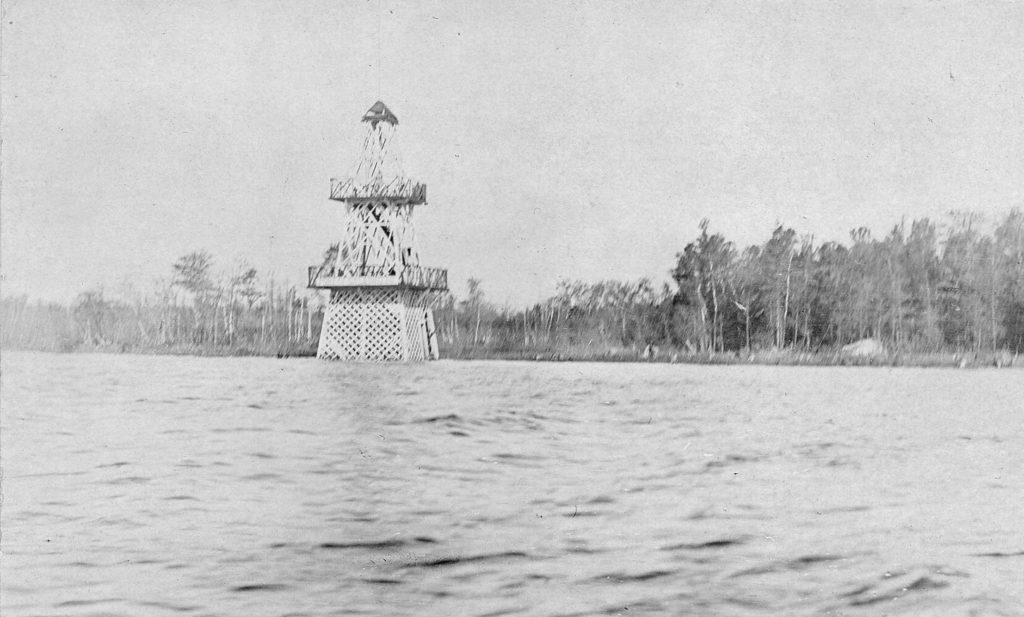
Original Castle Harmony Wooden Lighthouse
*
A lady’s changing room was eventually located in the base of the lighthouse for the privacy and convenience of future female guests who would often walk the path from the lodge out to the point where the lighthouse was located to swim in Great Moose Lake.
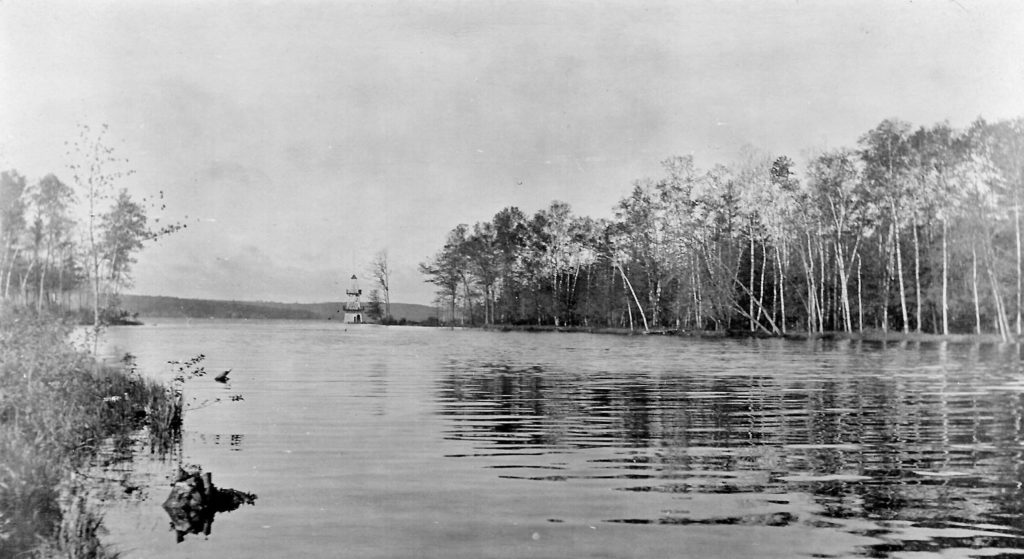
Original Castle Harmony Lighthouse from Main Stream
*
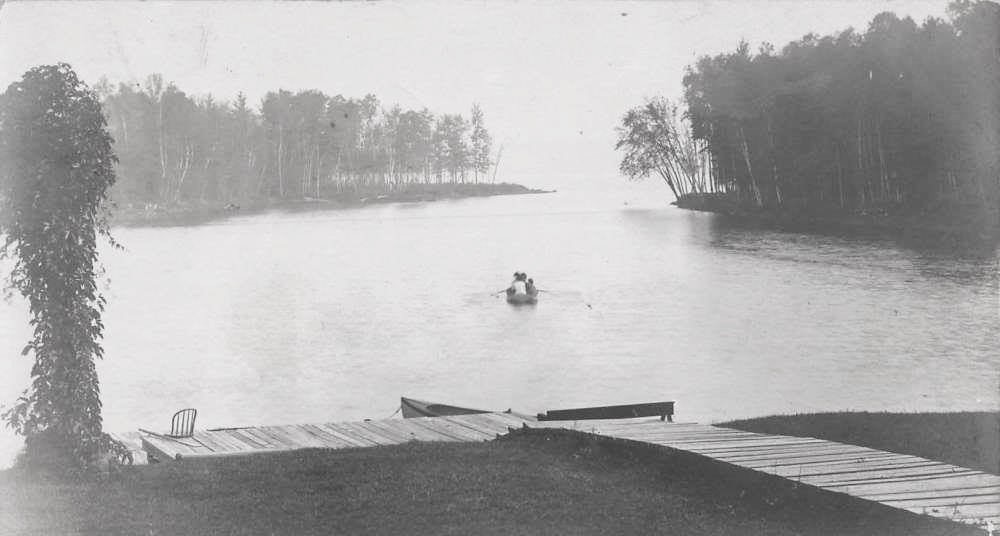
Looking across the cove, aka “Port of Galashiels”, on Main Stream from Castle Harmony onto Great Moose Lake
*
Over the years, 5 buildings were added to the Wild Goose Club compound along with major improvements to the grounds and its shoreline along Main Stream. The new buildings included the Sleepy Hollow Guest Lodge, Boat House, Carriage & Sleigh House, Horse Barn and a large Wood Shed.
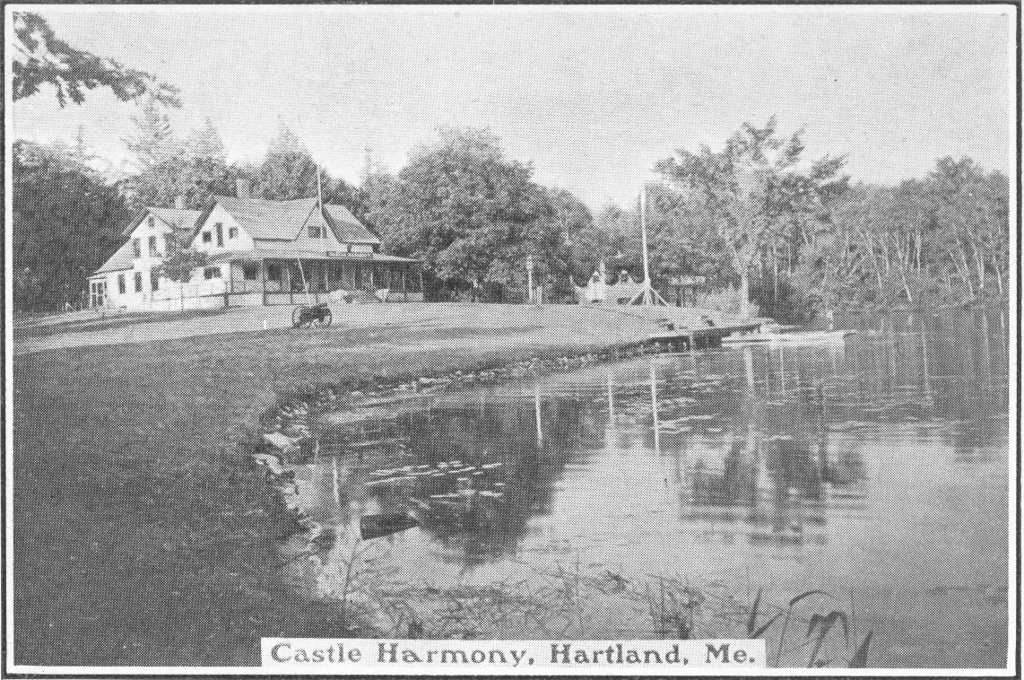
Castle Harmony Main Lodge & Boat House
*
Among the new buildings was the Sleepy Hollow Guest Lodge built to accommodate the growing number of its members & guests.
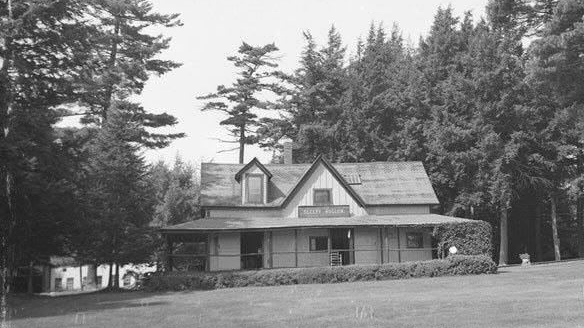
Sleepy Hollow Guest House
*
In 1886, the Sebasticook & Moosehead Railroad line opened from Pittsfield to Hartland providing a quicker and certainly more comfortable last few miles of travel to Hartland before the short carriage ride over to the Sebasticook River Boat Launch to head up to their Great Moose Lake destination.
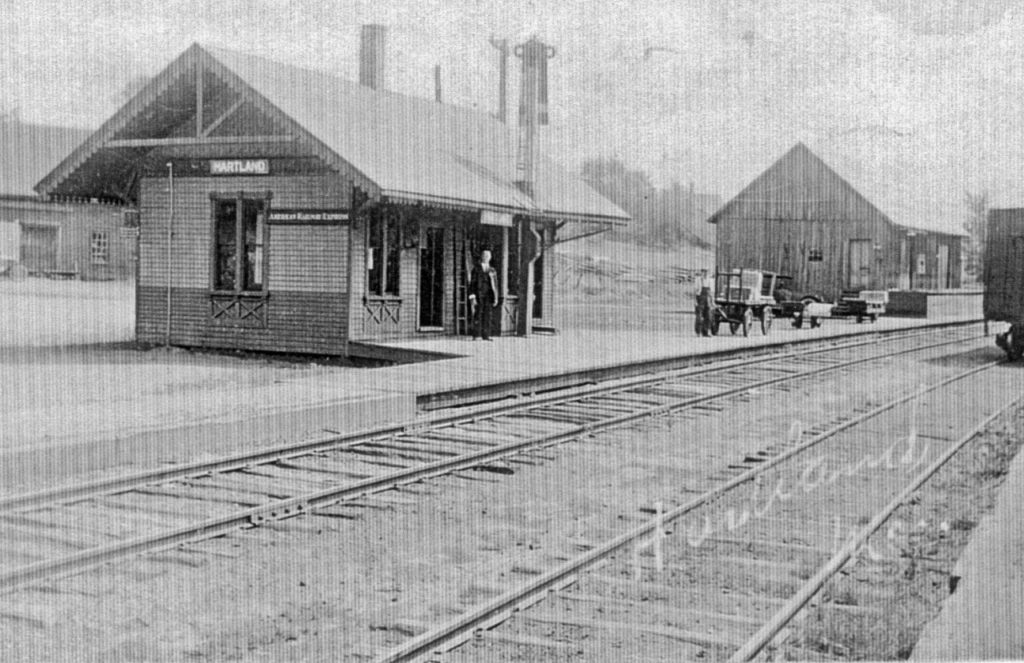
Sebasticook & Moosehead Railroad Hartland Depot
*
These unknown gentlemen, photographed below at Lewis B. Wheeler’s General Store on Outer Main Street next to the Hartland Railroad Depot in the early 1900s, were likely traveling members and guests of the Wild Goose Club geared up for fishing and on their way to Castle Harmony.
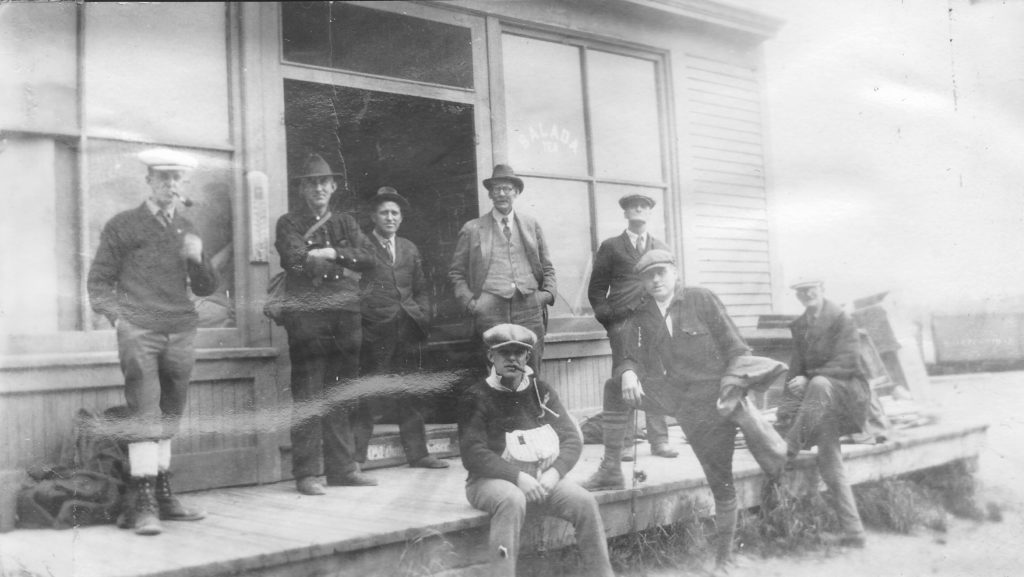
Travelers at L. B. Wheeler’s General Store
*
On August 9, 1887, Commodore Henry Hastings passed away at his home in West Medford, Massachusetts about a month before his 69th birthday. His life and illustrious career as well as his numerous historical family connections were detailed in his death notice which also included mention of his association with Castle Harmony. His mother Roxanna (Warren) Hastings was also a cousin to Dr. John Warren, proprietor of the township which became Hartland, and brother of Joseph Warren.

Boston Evening Transcript – Published August 9, 1887
*
On November 18, 1889, Archibald Linn passed away at 71yrs old. Mr. Linn was born in Biggar, Scotland in 1818 and moved to nearby Galashiels, Scotland in 1842 following his marriage to Grace Wilson where he first engaged in the woolen industry. They came to Massachusetts with their young family in 1848 where Archibald continued to hone his skills at several local woolen mills. Following a brief business partnership at a woolen mill in Dexter, Maine in the late 1850s, he relocated to Hartland where he built his own woolen mill in 1863 and became a leading businessman and large landowner.
*
Update in Progress!
~ The Commodore Club ~
Many of the distinguished guests of The Wild Goose Club desired to become official members of the elite sporting and social club however the club’s standing by-law limitation of 15 members thwarted many of their efforts. These early membership limitations appear to be at least part of the catalyst for the formation of a new sporting club in the late 1880s led by the efforts of Commodore Hastings’ son, Col. Henry Hastings (1857-1917) and several of his business, political and military associates from Massachusetts and Maine.
As later noted in an 1891 Republican Journal article, “This club originated from The Wild Goose Club where they (as guests) were so pleased with the hunting, fishing and scenery, that it was concluded to build a clubhouse and form a new club with 150 members.”
“The Commodore Club”, almost certainly named in honor of the late Commodore Henry Hastings, maintained a close and ongoing association with The Wild Goose Club but operated as a separate entity. Members of the newly formed club acquired a select piece of property on the Hartland side of Great Moose Lake and began construction around 1888 on a dedicated lodge for their club headquarters.
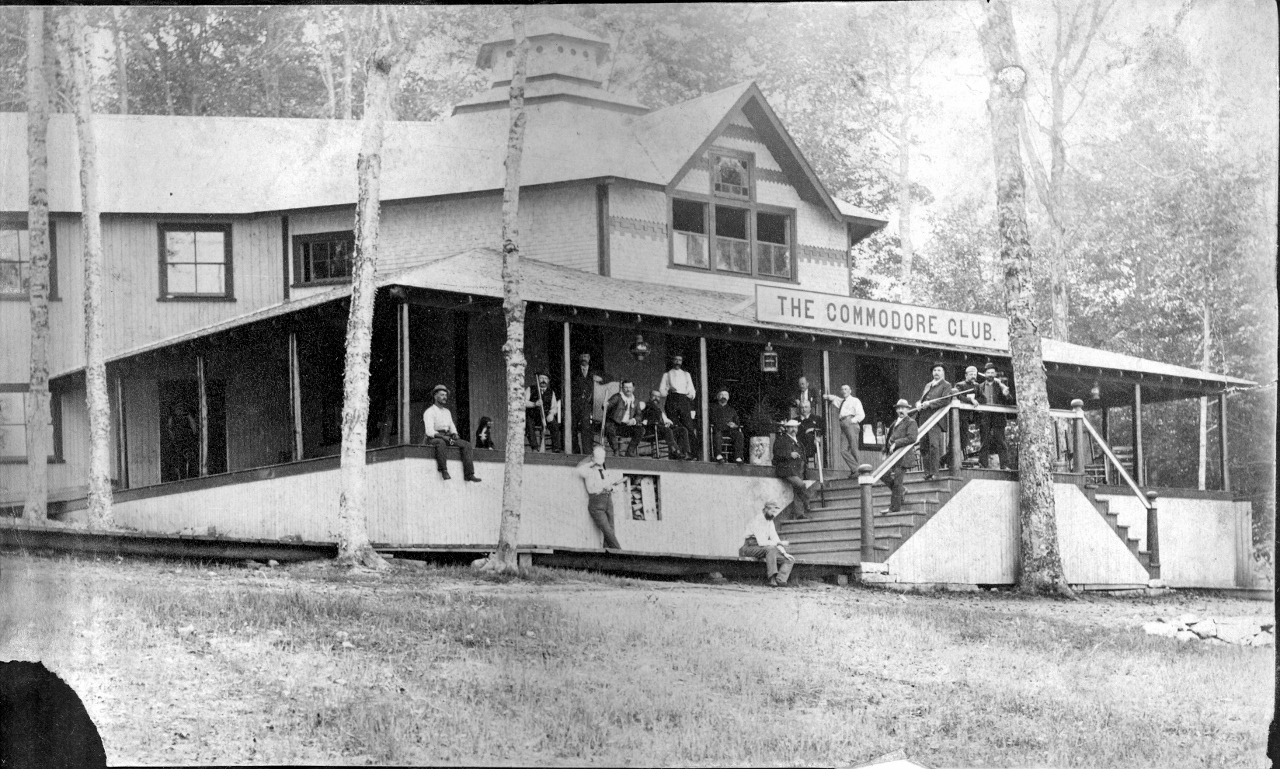
The Commodore Club Lodge – 1917
*
Completed by early 1890, the new Commodore Club Lodge replicated in part many of the rustic construction features found at Castle Harmony. A large and well supplied dining room featuring fine china, crystal and linens provided its members & guests very comfortable dining accommodations during their stay.
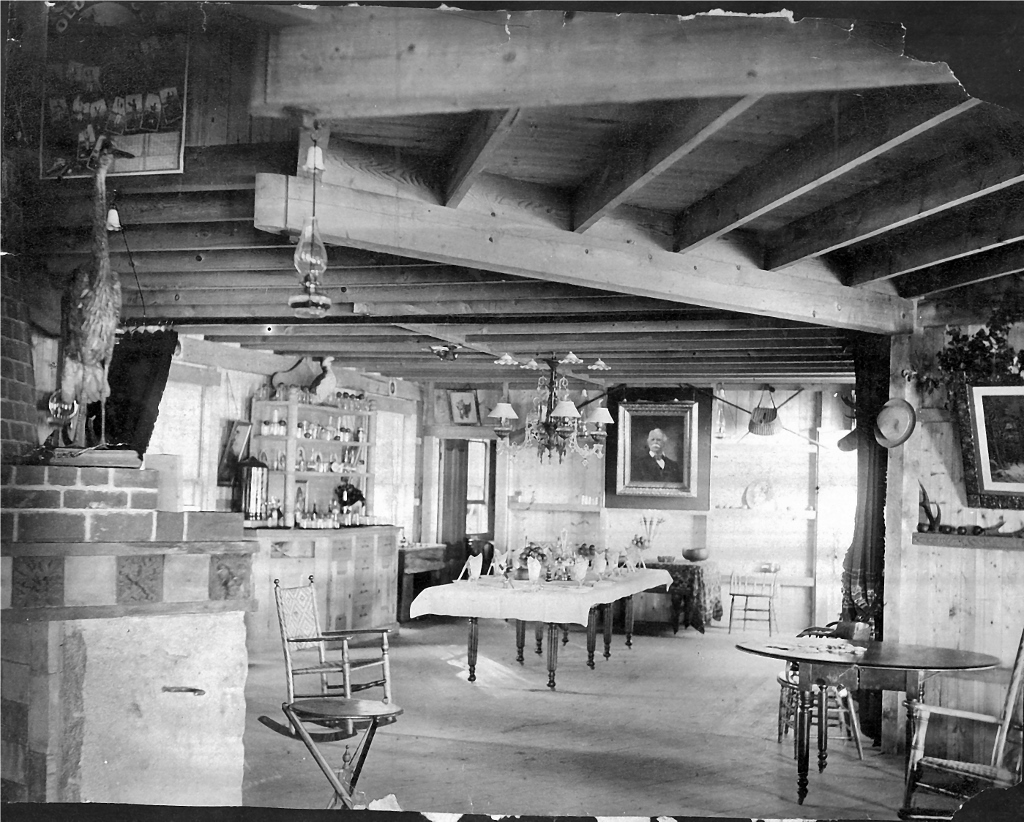
The Commodore Club Lodge Dining Room Area
*
Dining at the new Commodore Club Lodge included engraved silverware.
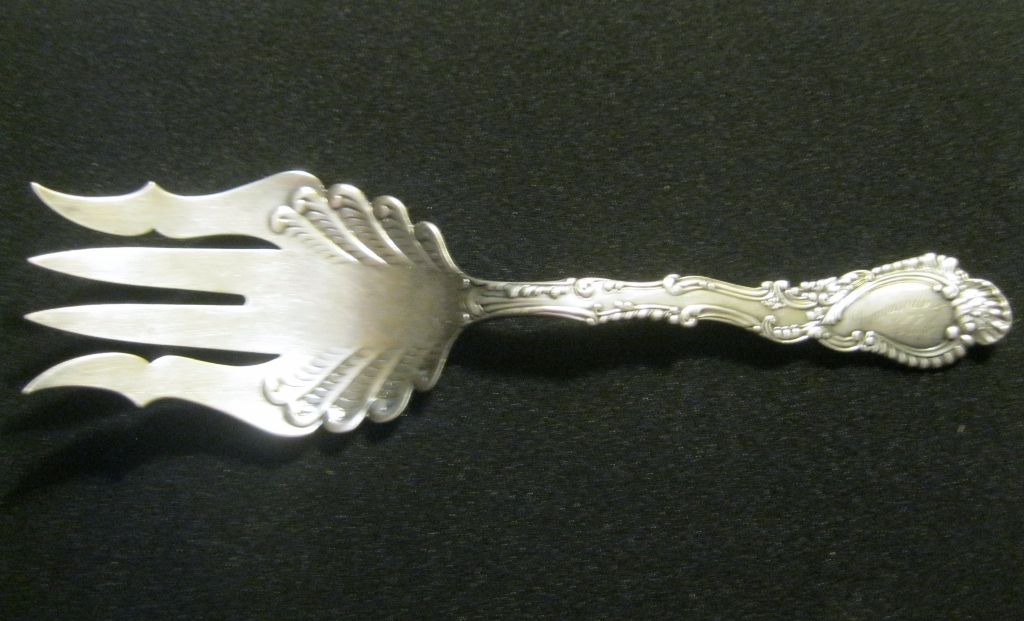
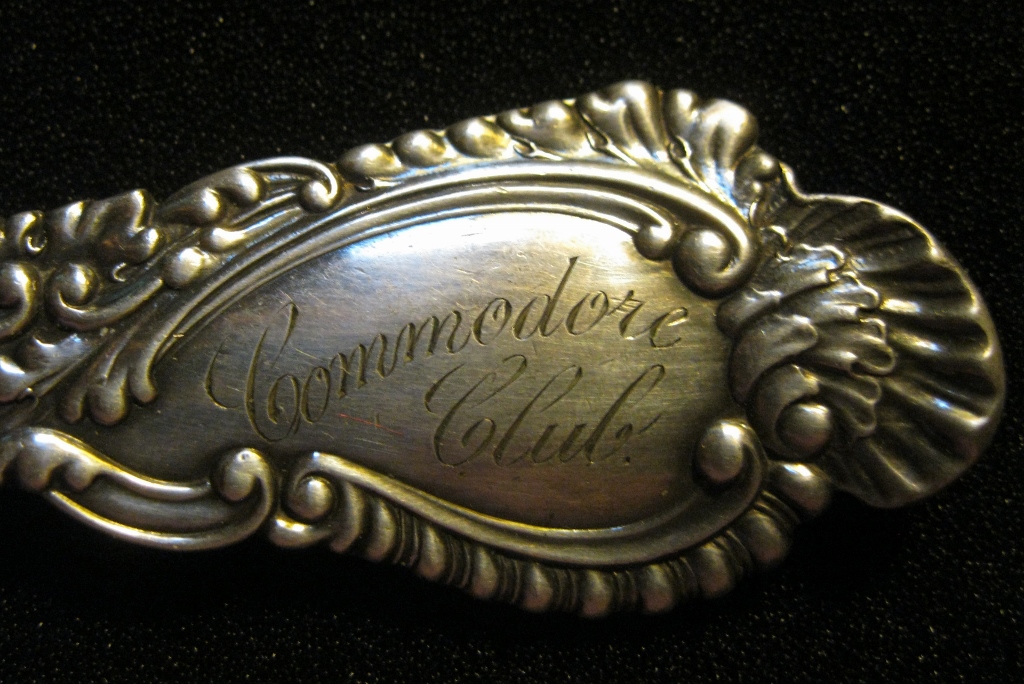
Commodore Club Silver Serving Fork
(Donated by Gerald & Pat Martin)
*
A November 17, 1894 newspaper article from the Lewiston Sun Journal provides several tidbits of information describing a trip made to Castle Harmony by then Massachusetts Governor Frederic Thomas Greenhalge. He served 3 consecutive terms as the 38th Governor and died during his last term in 1896. He was also the first foreign born Massachusetts Governor. Click the link below for the full story.
Lewiston Sun Journal Article 1894
*
Wild Goose Club Members and Guests pose for a traditional photo at the Castle Harmony Main Lodge in 1898.
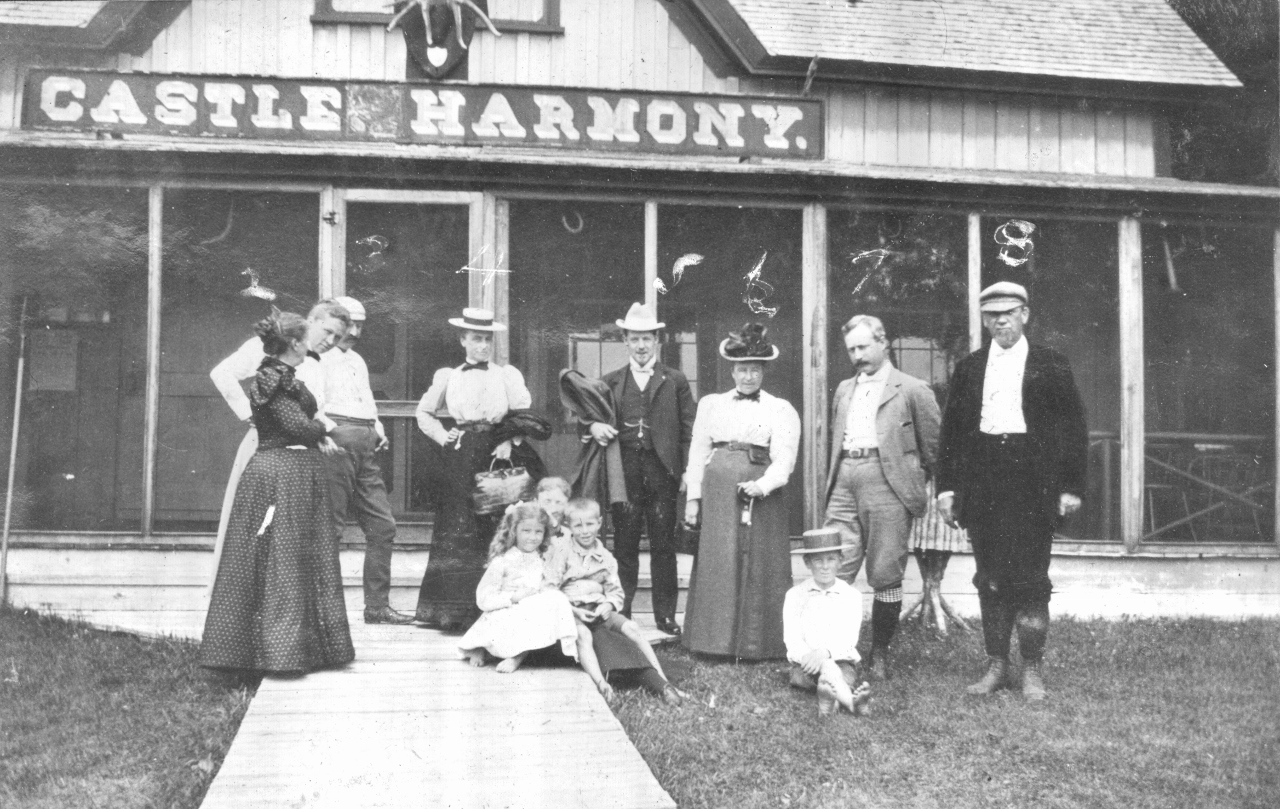
1. Mrs. Renfrew 2. Mrs. Hall 3. T. VanValkenburgh 4. Mrs. Davidson 5. H. T. Hayward
6. Mrs. A. M. Silsbee 7. William Hall 8. James Renfrew. The children were not identified.
*
By the early 1890s, The Wild Goose Club had voted to increase its original by-law 15 member limitation to 25 members. In 1895, by a vote of club membership during their annual business meeting in Boston, membership was increased again to a maximum of 35 members.
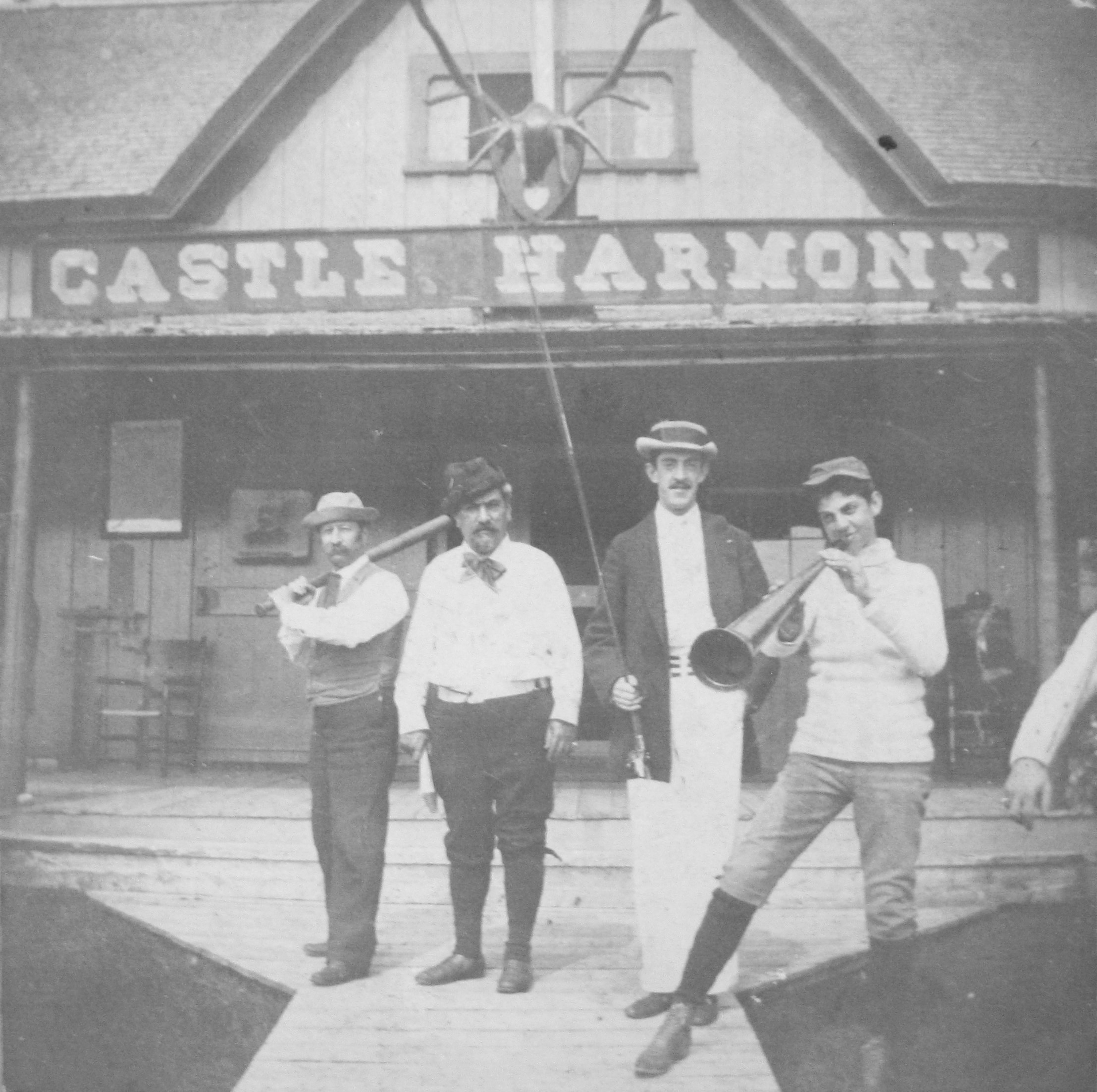
Unidentified group photo at Castle Harmony
*
In 1901, the Sebasticook & Moosehead Railroad opened a new railroad line extension from the Hartland Village Depot to Main Stream in Harmony. Castle Harmony soon had its own dedicated train stop located just before the Main Stream stop. The club built a private rail siding at the stop to park their private Pullman Passenger Cars. Members and guests could now travel from Boston directly to the compound with relative ease.
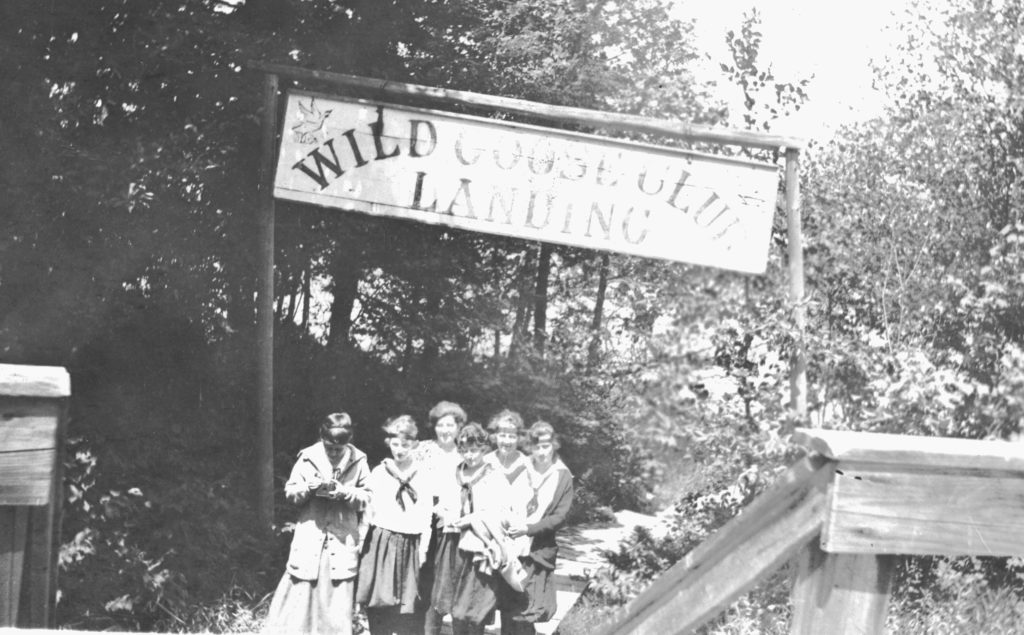
Sebasticook & Moosehead Railroad Wild Goose Club Landing – 1923
*
The updated Sebasticook & Moosehead Railroad Schedule following its expansion to Main Stream on Great Moose Lake.
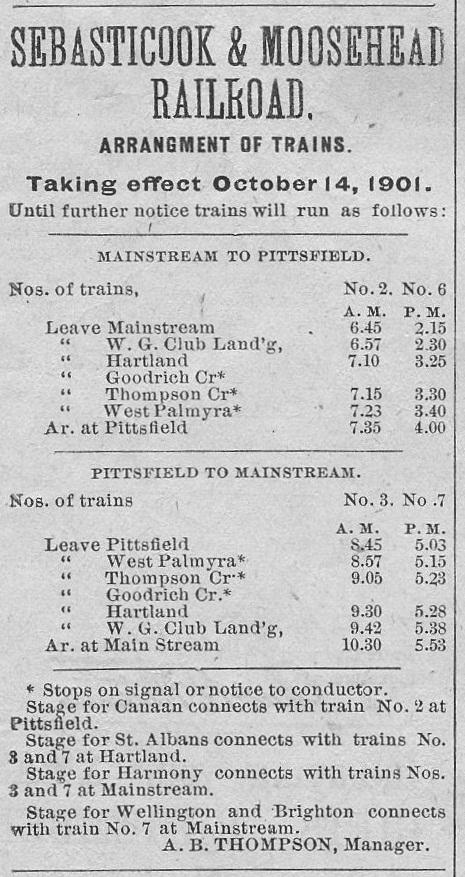
Sebasticook & Moosehead Railroad Schedule – 1901
*
The Castle Harmony compound distinctively stood out along Main Stream’s shoreline.
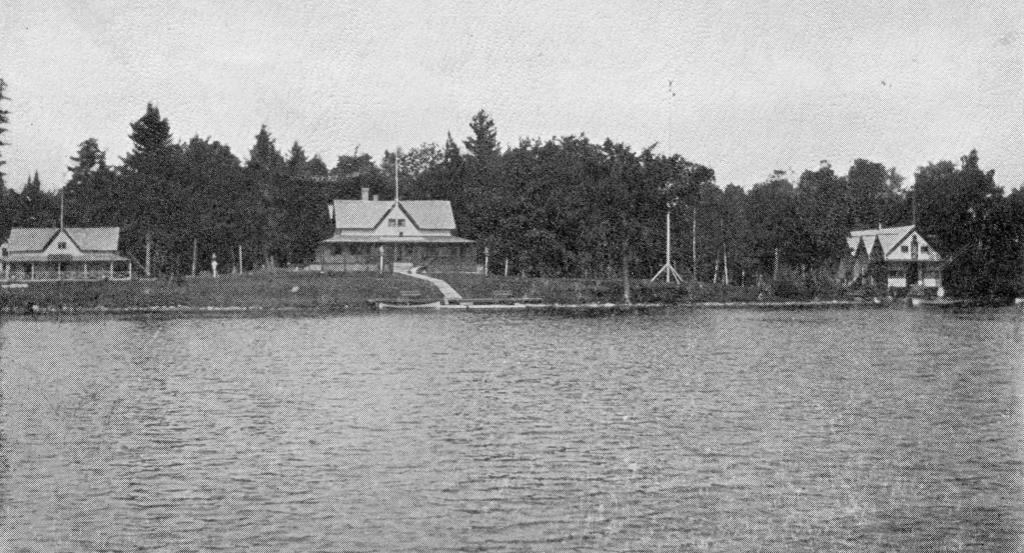
Sleepy Hollow Guest House, Castle Harmony Main Lodge & Boat House
*
The Commodore Club was located across from Castle Harmony on the Hartland side of Great Moose Lake.
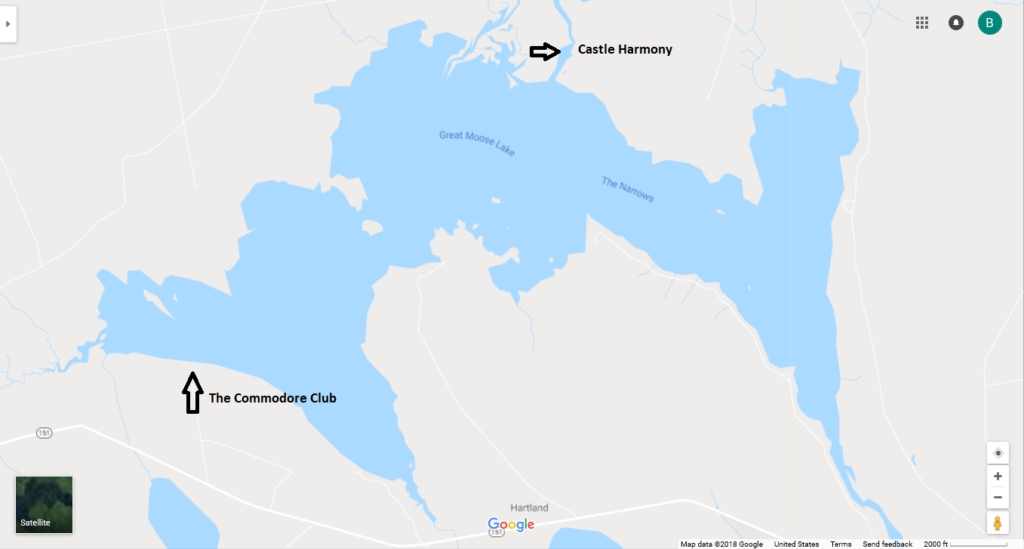
Great Moose Lake
(Photo by Google Maps)
*
The library at Castle Harmony was a centerpiece of activity hosting several generations of Wild Goose Club Members & Guests as seen in this March 1901 photo of an evening poker game. The poker table would remain a familiar fixture in the library for decades.
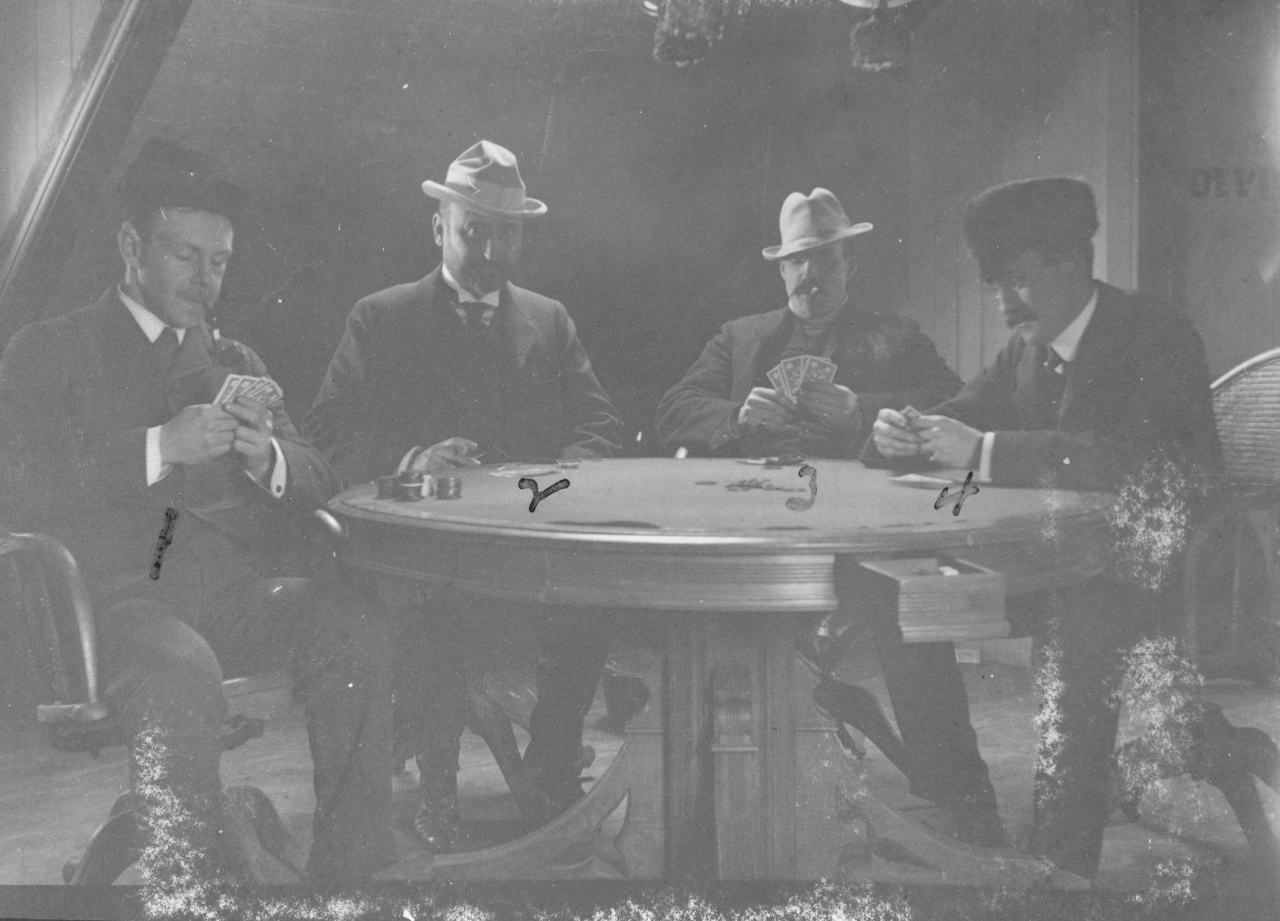
1. C. B. Gleason 2. George F. Parker 3. George W. Hastings 4. Ralph Linzee Hall
*
Wild Goose Club Members involved in a little literal horseplay at Castle Harmony in March of 1902.
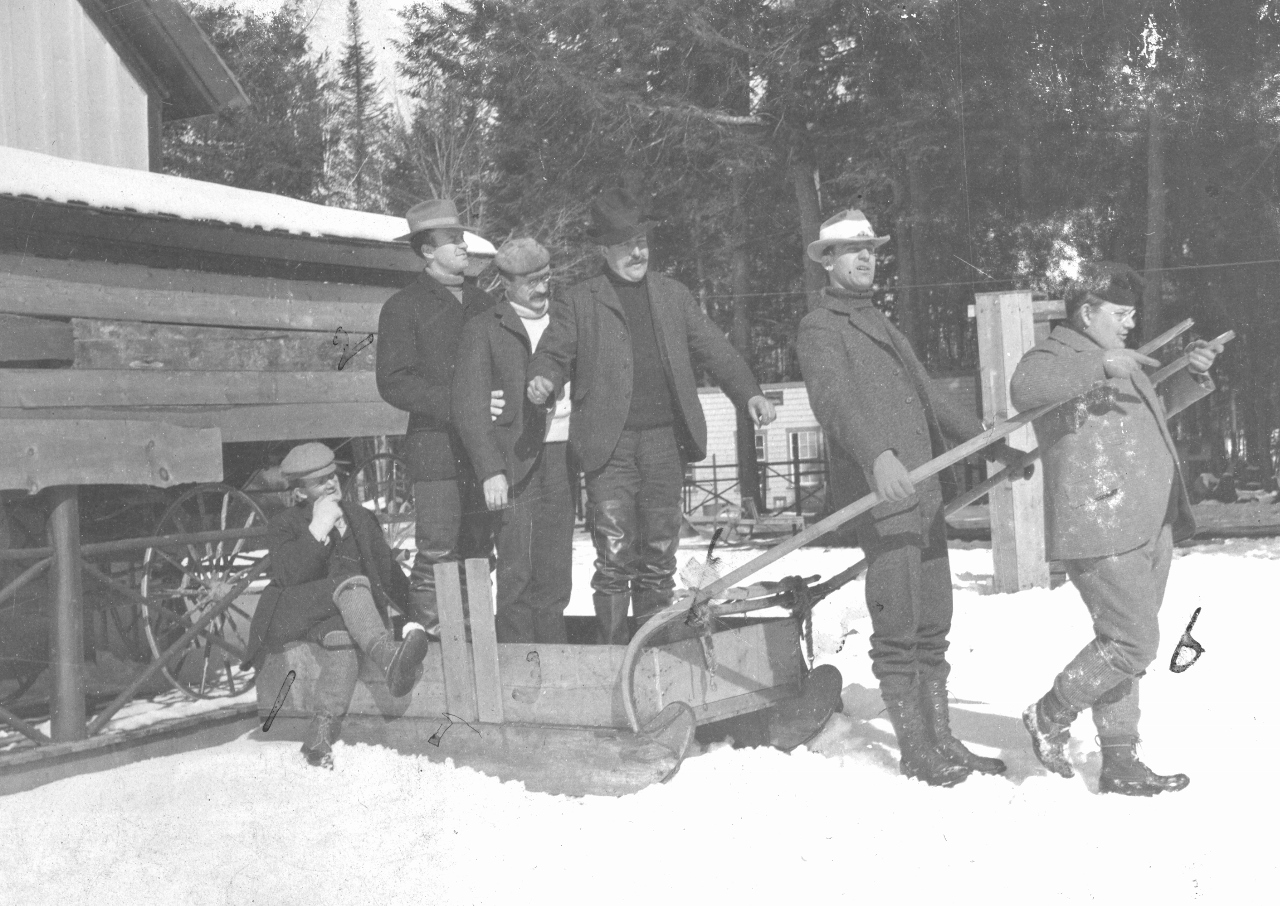
1. Charles H. Warren 2. L. Williams 3. Ralph Linzee Hall 4. B. W. Wells 5. C. H. Cole Jr 6. W. T. Jeremy
*
Wild Goose Club Members had long owned private boat launches which were later delivered directly to the club via railroad.
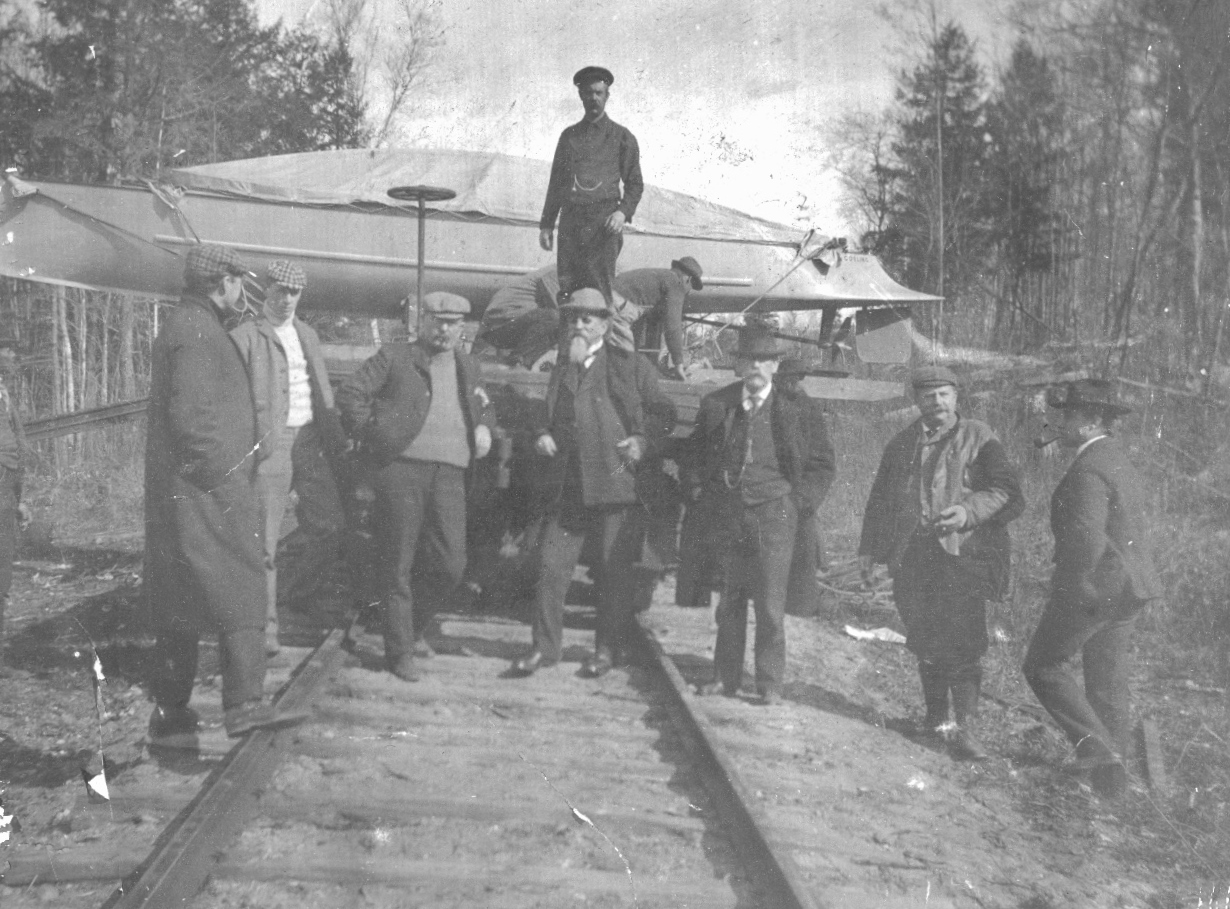
Wild Goose Club Members take delivery of a new boat launch at their railroad stop in 1903
*
The launches allowed Club Members and Guests to venture about the lake and later shuttle between Castle Harmony and The Commodore Club. Each Club Member’s private boat launch were, of course, appropriately named by their owner. Among some of the known names of newer launches were “The Gosling”, “Black Maria” & “Gentle Susan”.
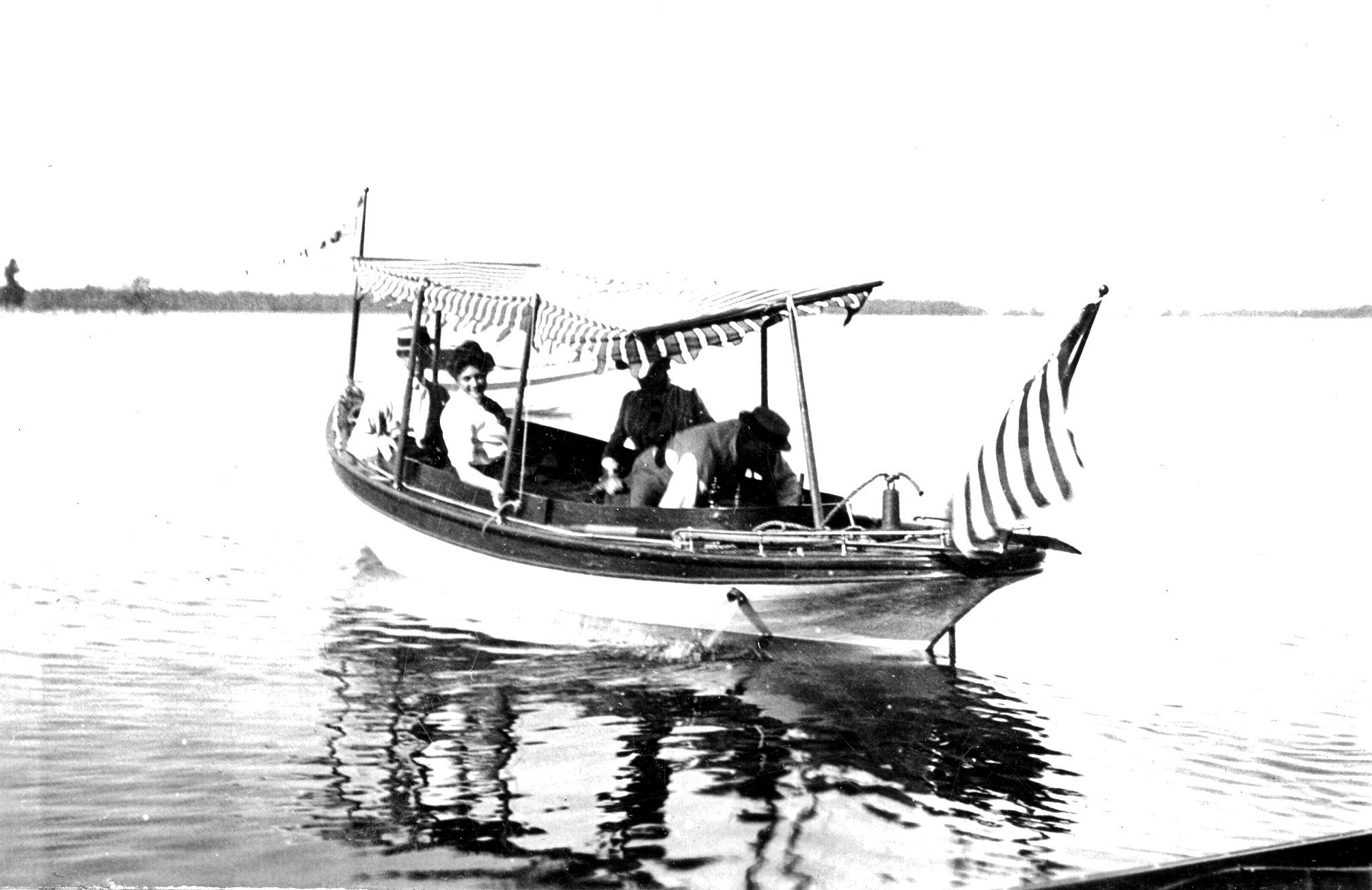
“The Gosling” on Great Moose Lake
*
In 1911, the original wooden Castle Harmony Lighthouse was blown over and destroyed during a major storm. A new iron framed lighthouse tower was built the following year on the same location as the original lighthouse at the entry of Main Stream from Great Moose Lake.

New Iron Frame Castle Harmony Lighthouse Tower – Built in 1912
*
Remains of the Iron Frame Lighthouse Tower can still be seen today albeit it nestled in the brush and trees along the shoreline.
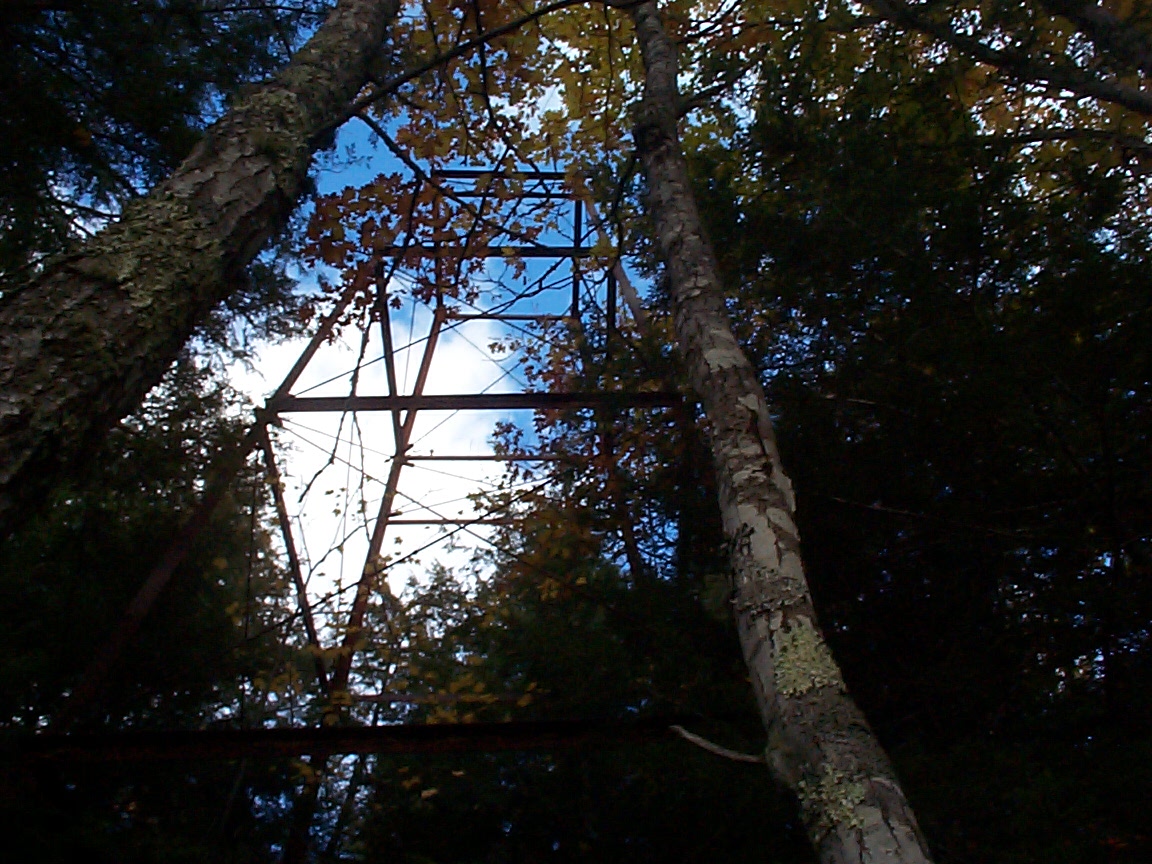
Iron Frame Castle Harmony Lighthouse Tower – 2002
*
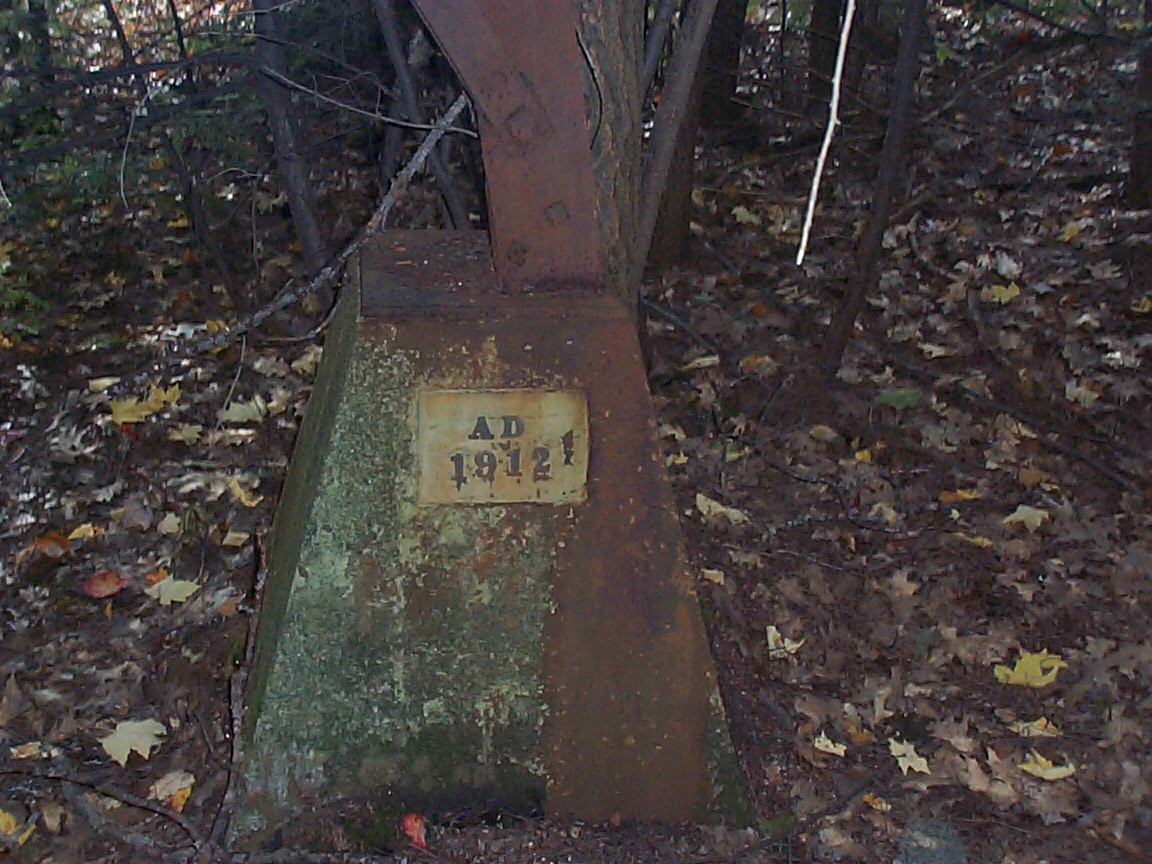
Date Plate at the base of the Iron Frame Castle Harmony Lighthouse Tower – 2002
*
George W. Hastings was one of the later generations of presidents of the Wild Goose Club and bestowed the time honored title of “Commodore”. His relationship to Commodore Henry Hastings, if any, is currently unknown.
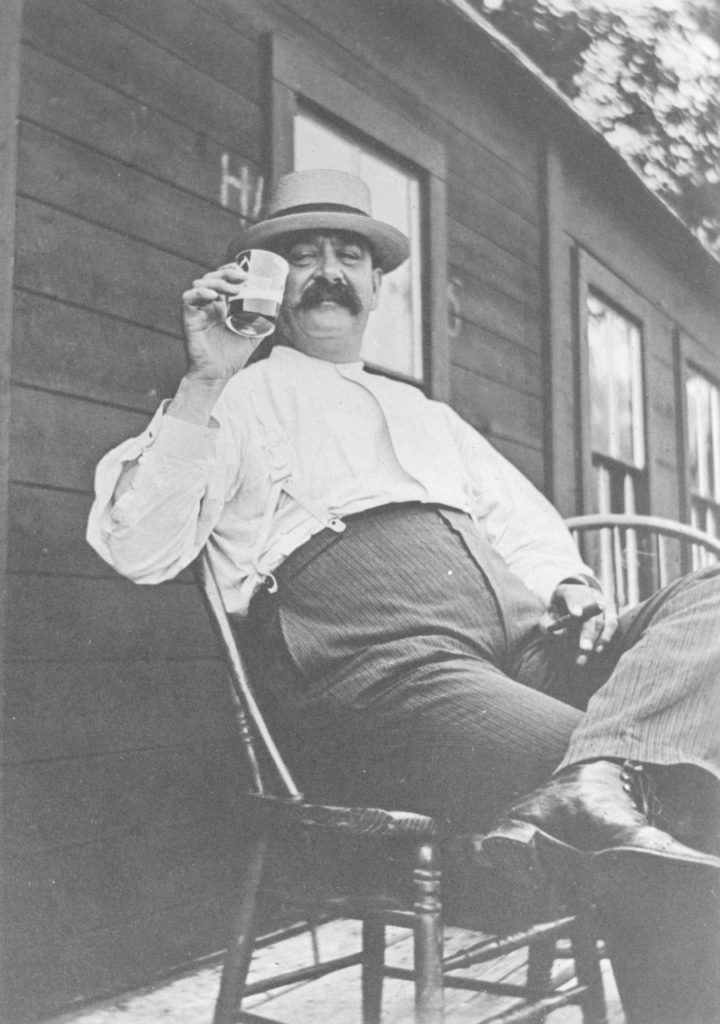
Commodore George W. Hastings
*
The Wild Goose Club & Commodore Club both provided members & guests with an ultimate yet quite comfortable wilderness adventure.
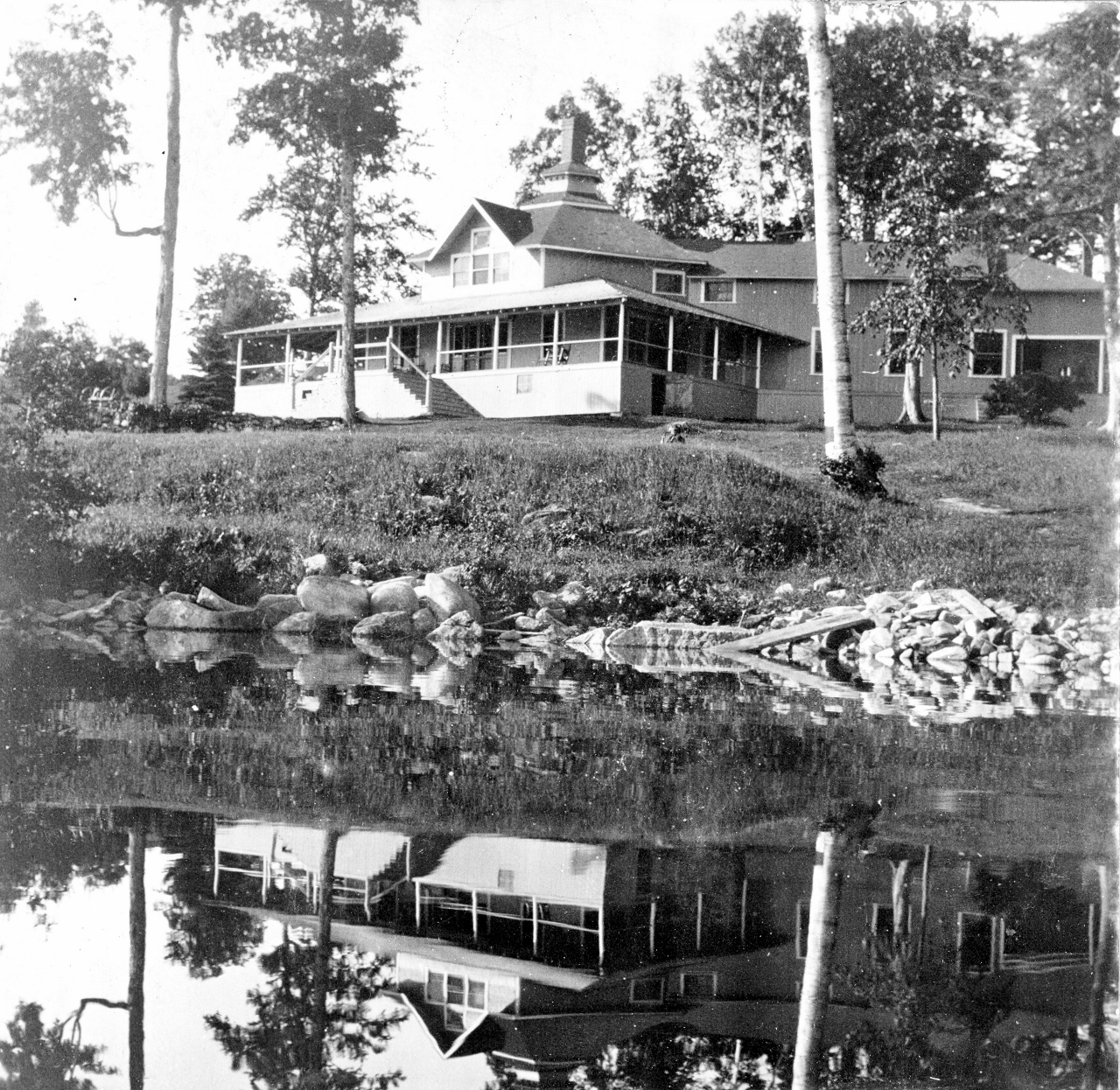
The Commodore Club Lodge
*
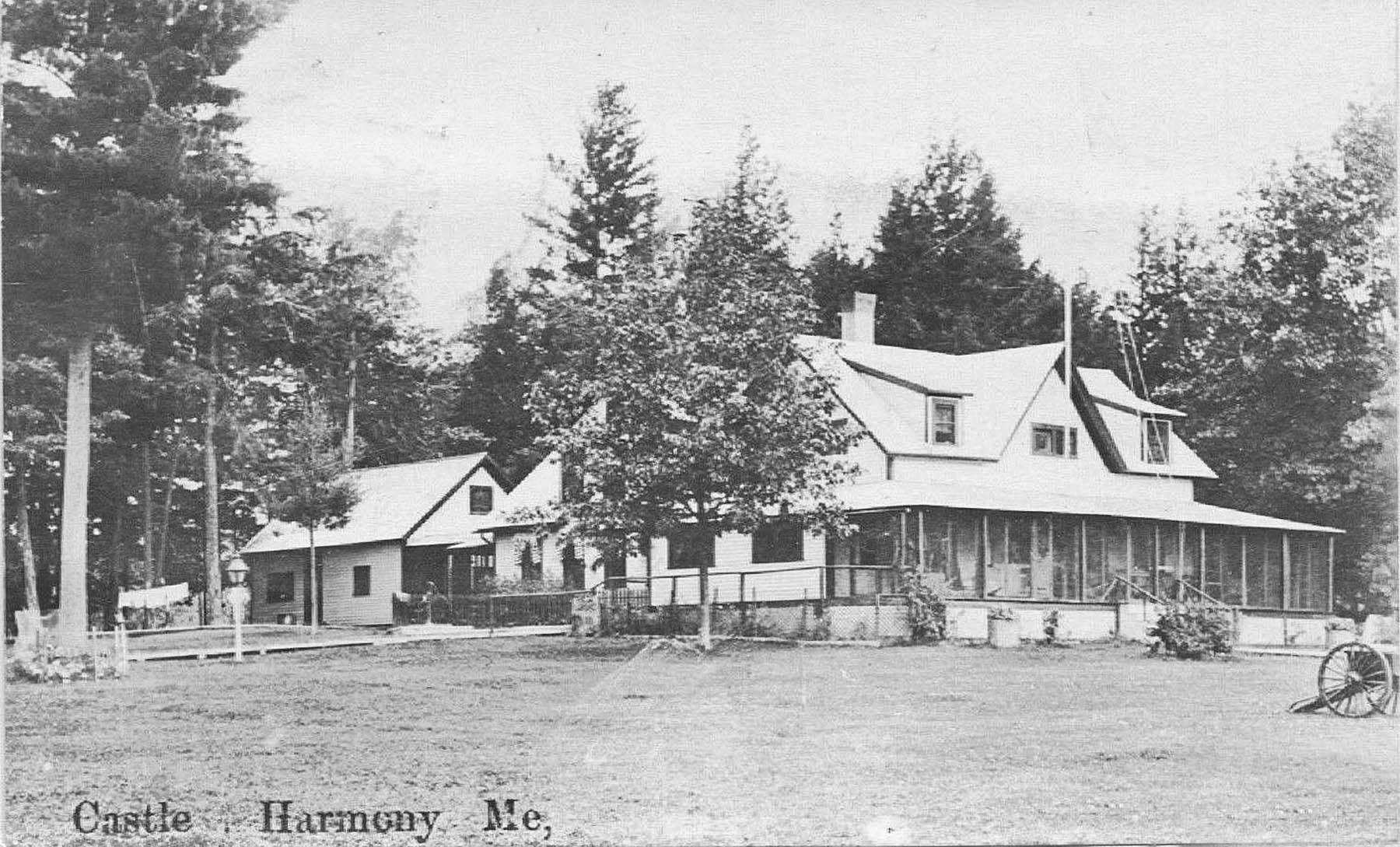
Castle Harmony Main Lodge w/Rear Addition
*
Not every so called “sportsman” who came to Castle Harmony was male as Mrs. E. T. Bigelow demonstrates women were just as capable as she takes aim from the porch of the Castle Harmony Lodge in October of 1902.
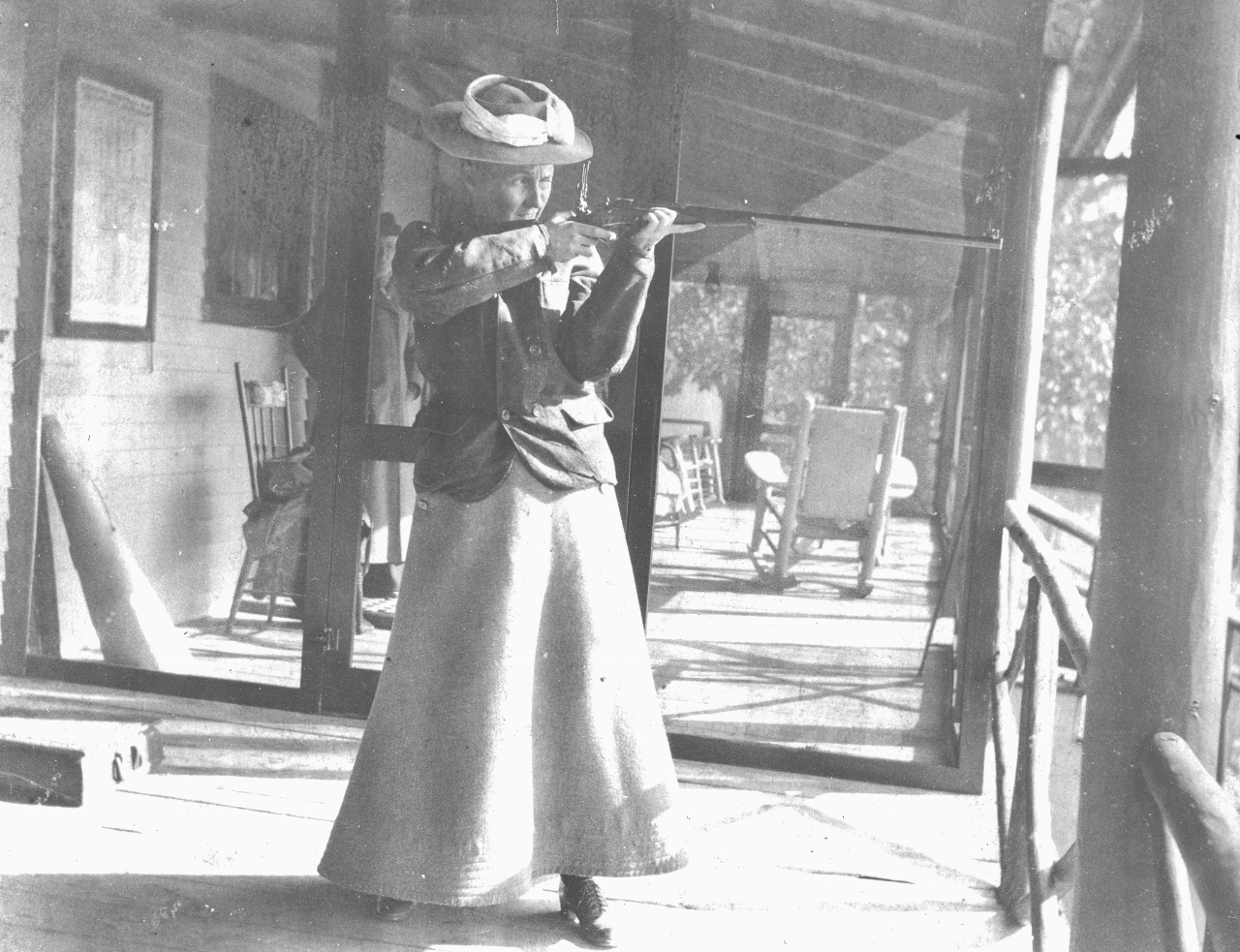
Mrs. E. T. Bigelow
*
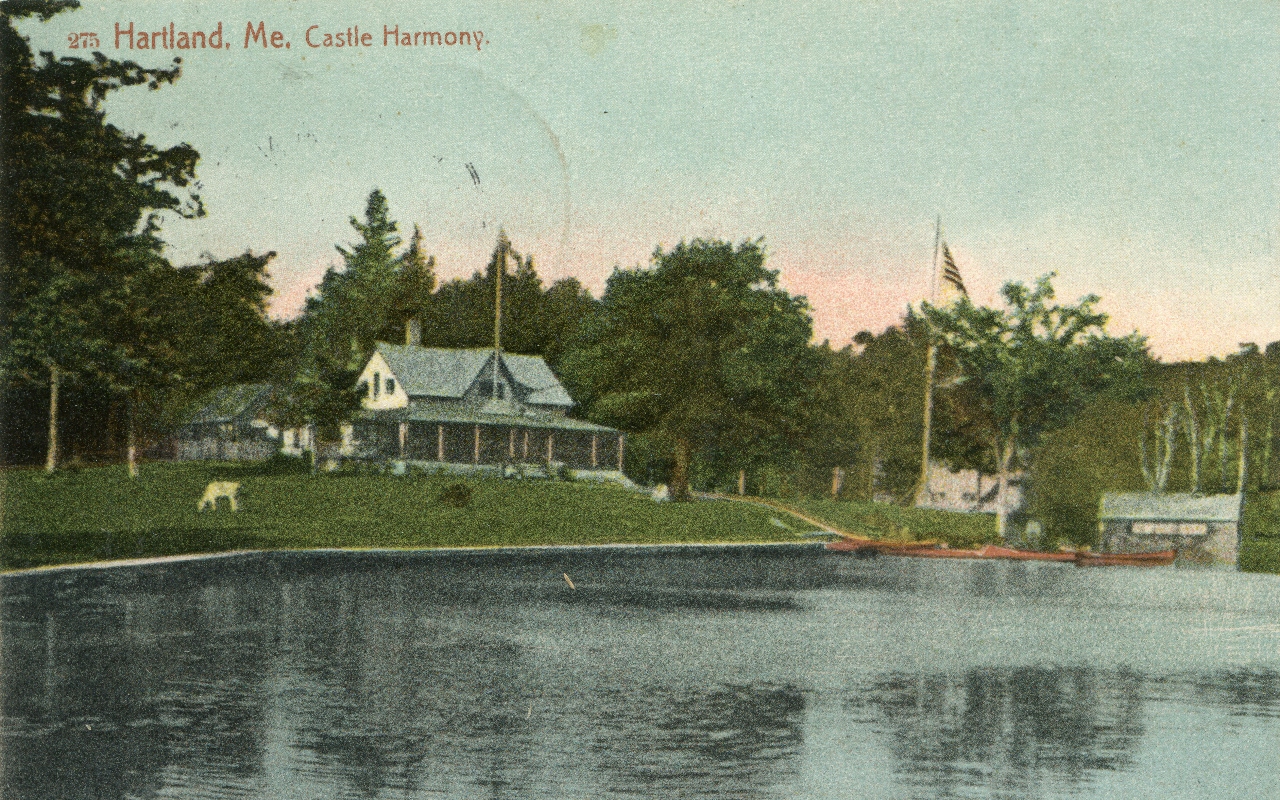
Castle Harmony
*
Hunting at the Wild Goose Club was enjoyed by both men and women as seen in this October 1902 photo.
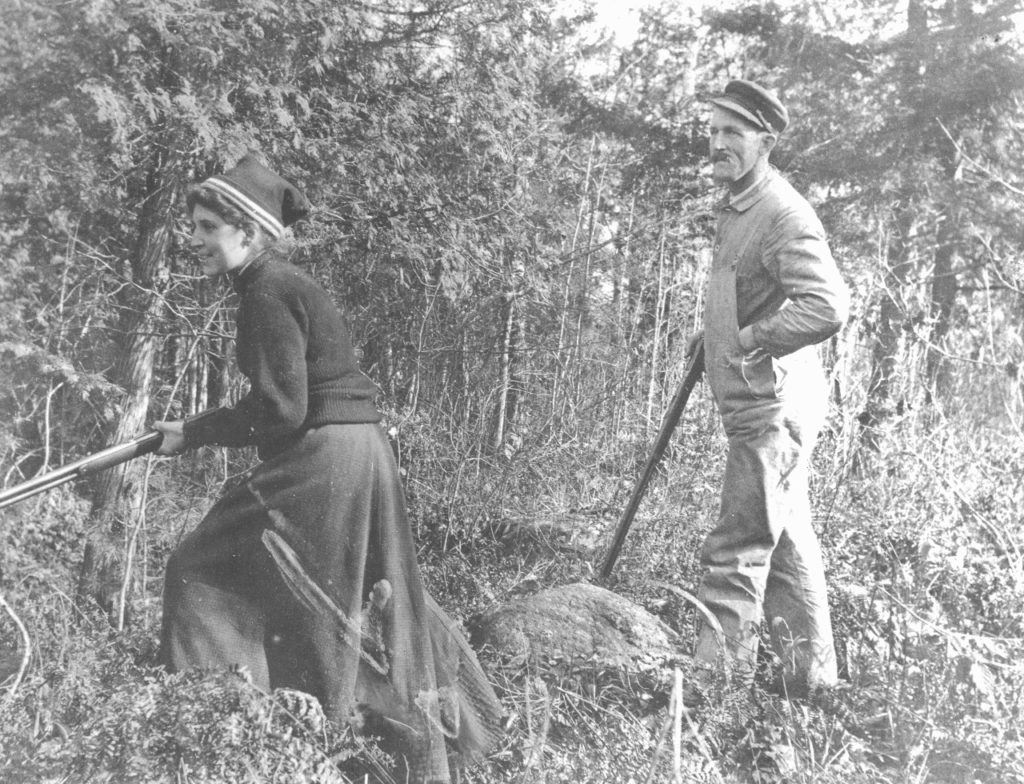
Mrs. S. Gleason & Frank Linnell
*
Wild Goose Club Members & Guests pose on the front steps of the Castle Harmony Lodge for a traditional photo in 1903.
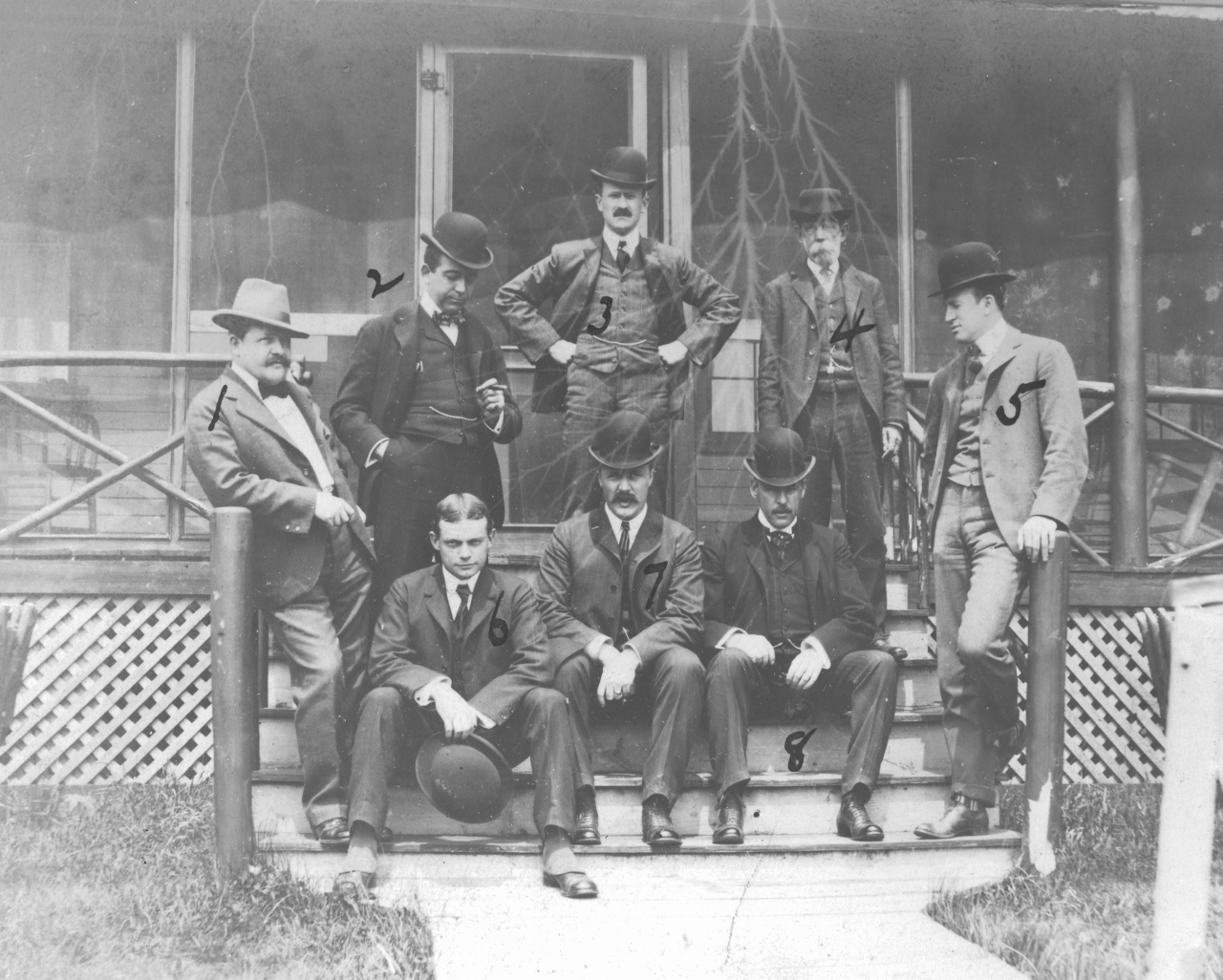
1. Allan Taylor 2. F. P. Royce 3. Ralph Linzee Hall 4. J. K. Mannin 5. L. Williams 6. John Dearborn 7. T. Woods 8. E. R. Champlin
*
Fishing on Great Moose Lake was another popular excursion for Wild Goose Club Members and Guests.
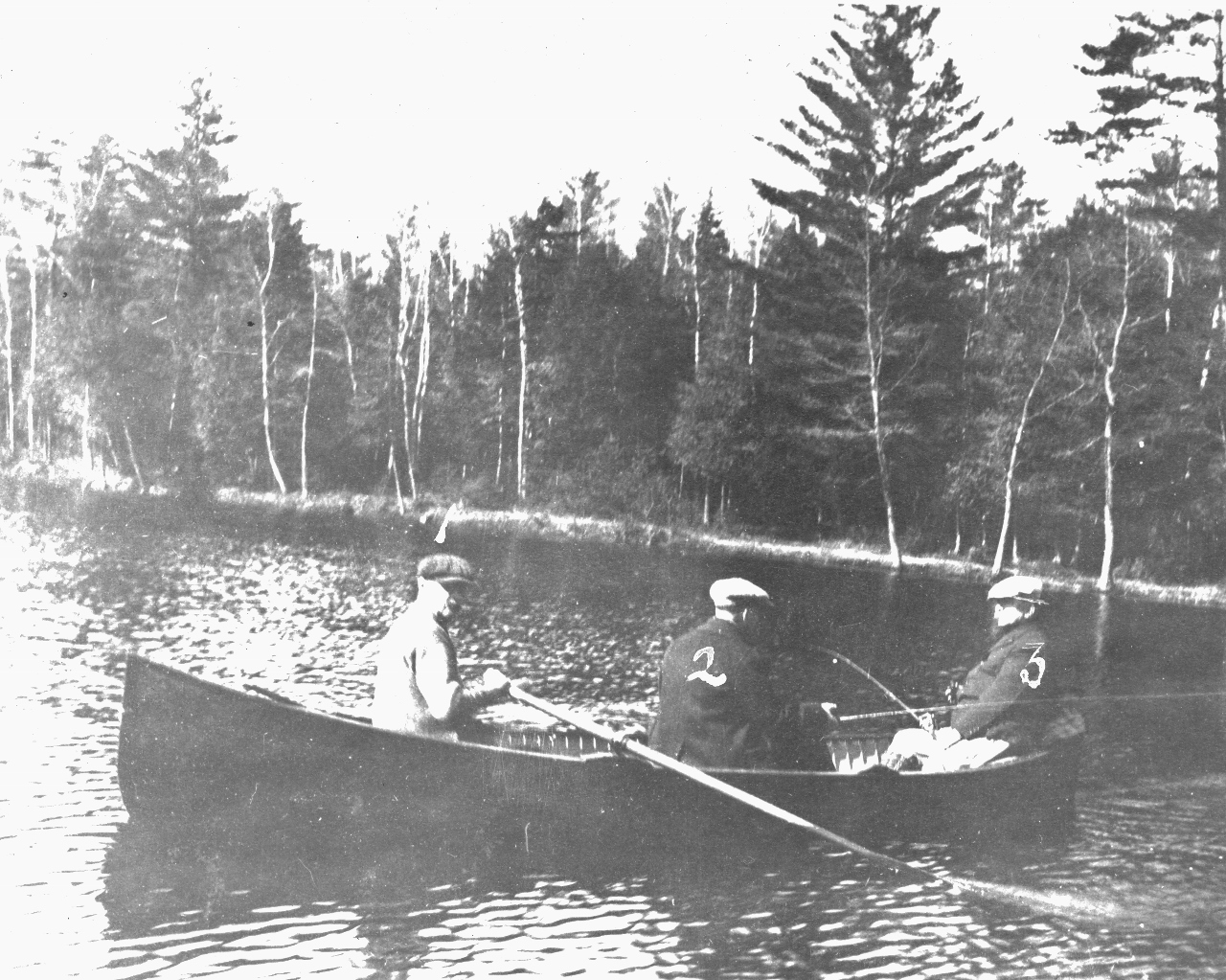
1. Charles Ricker 2. H. A. White 3. C. F. Murphy
*
The Great Fireplace at The Commodore Club was built on 3 solid granite blocks open on all sides. The story is told the massive stone and brick structure was replicated from relayed memories of a similar fireplace in a Scottish Hunting Lodge which Commodore Hastings had once visited.
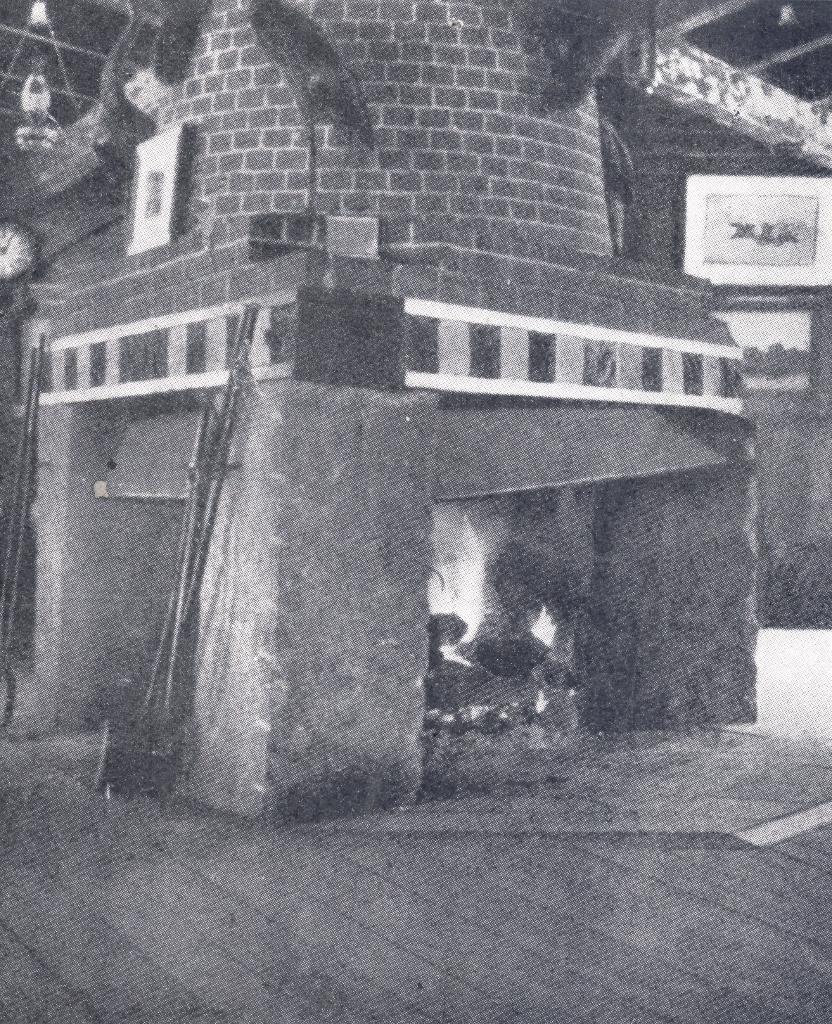
The Great Fireplace at The Commodore Club Main Lodge
*
Wild Goose Club Members & Guests pose for a photo on the front steps of Castle Harmony Main Lodge in 1917
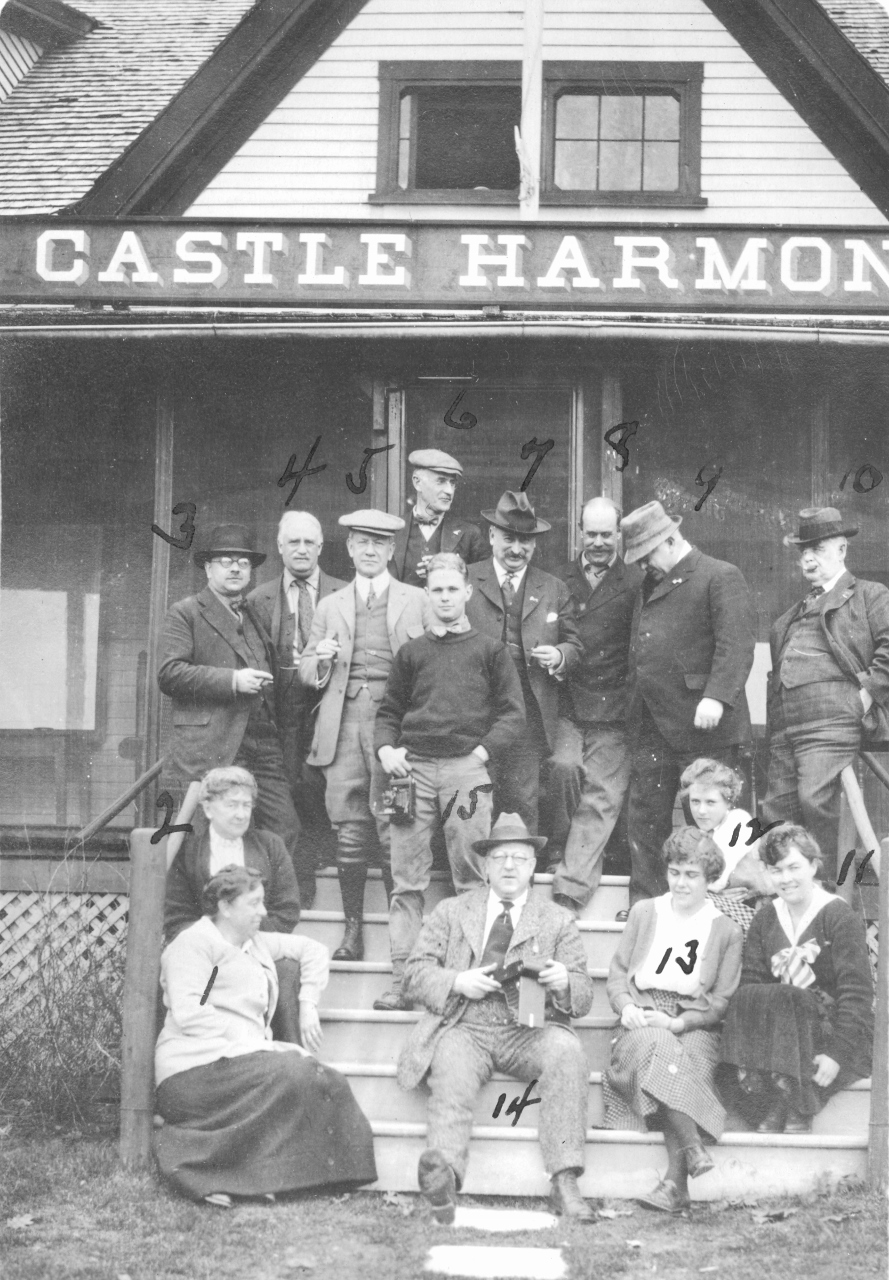
1. Mrs. Meigs 2. Mrs. Rice 3. S. P. Snow 4. Vernon Howard Hall I 5. William Sutton 6. Ralph Linzee Hall 7. George W. Hastings 8. E. T. Bigelow 9. G. Rueter 10. Harry Rice 11. Mrs. Keyes 12. Barbara Hall 13. Betty Bigelow 14. Dr. Meigs 15. Vernon Howard Hall II
We were contacted by Betsy (Hall) Nordell who informed us Ralph Linzee Hall & Vernon Howard Hall I are brothers and Vernon Howard Hall II & Barbara Hall are Ralph’s children. Betsy is the daughter of Vernon Howard Hall III.
*
Mrs. Keyes proved she was also an accomplished fly fisherman even in her long skirt and high button shoes as seen in this 1917 photo.
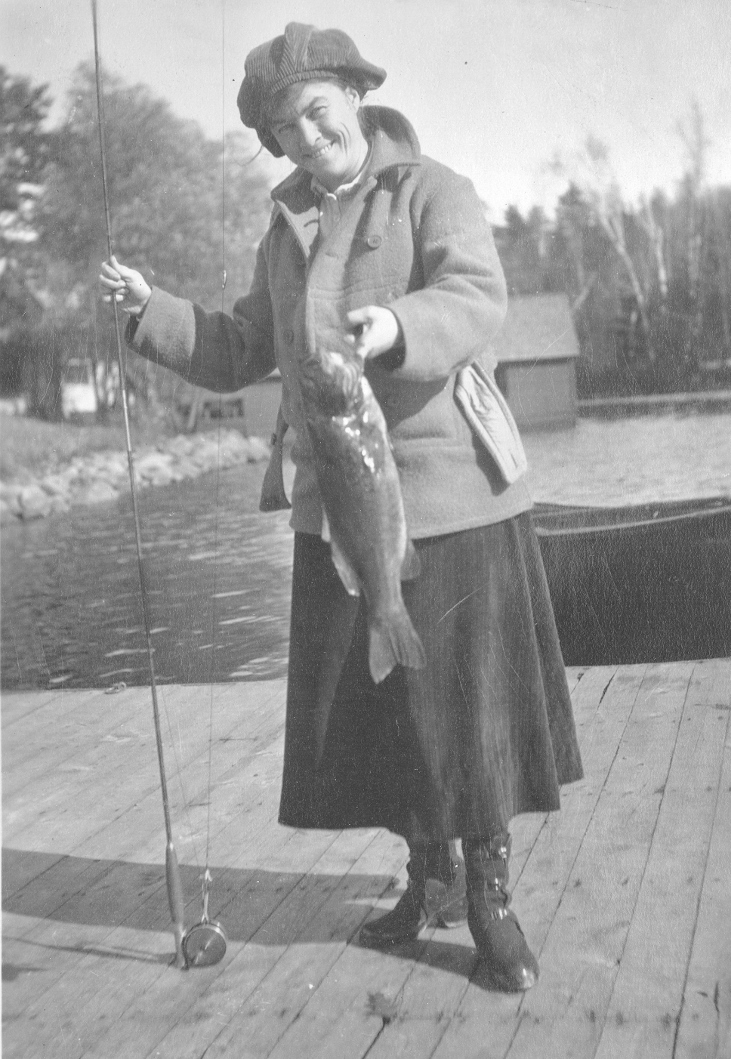
Mrs. Keyes with her impressive catch on the dock at Castle Harmony
*
A group of Club Members & Guests strike a pose for a photograph in front of The Commodore Club in 1917.
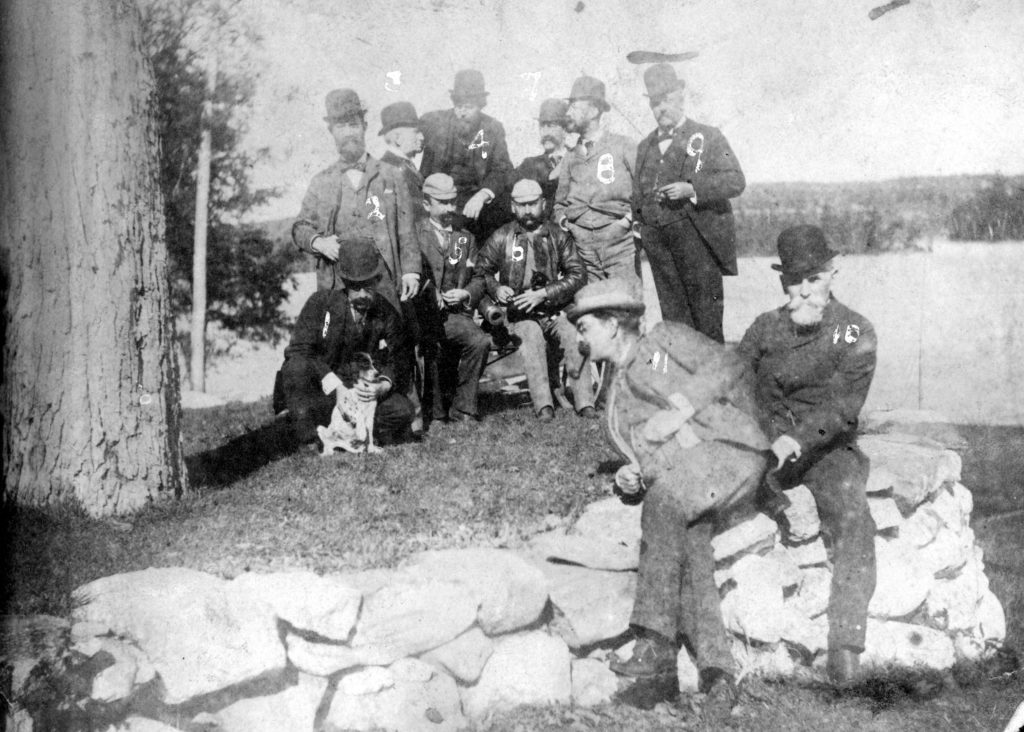
1. E. A. Adams 2. William V. Kellen 3. Rufus Brown 4. J. J. Enneking 5. George W. Hastings 6. B. T. Stephenson 7. F. S. Sherburne 8. C. L. James 9. William Lawrence 10. Henry Stephenson 11. ____ Hawley
*
The rooms at the Castle Harmony Main Lodge were well decorated and featured numerous photos of past Wild Goose Club Members.
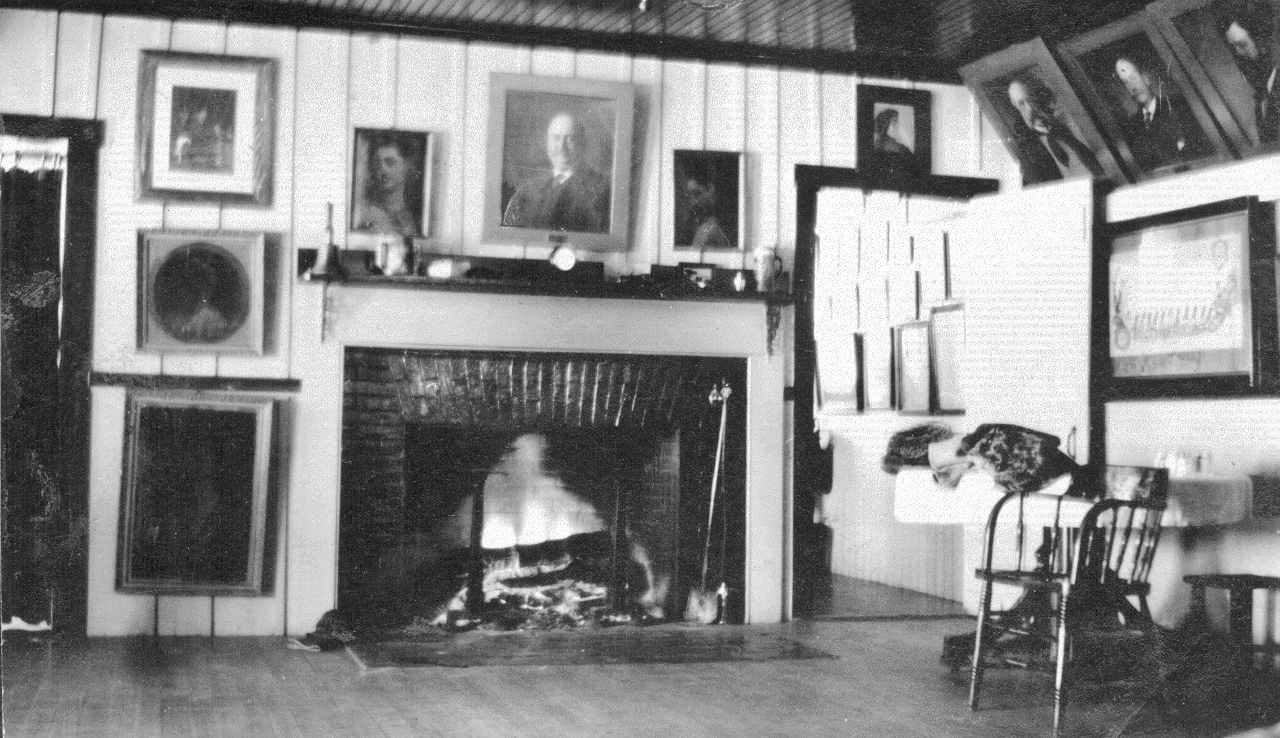
Castle Harmony Main Lodge
*
Update in Progress – June 5, 2024
Seen in the photo above hanging on the right is this undated painting below by one of the old Wild Goose Club Members, “DWC Farrington”, thought to be De Witt Clinton Farrington (1825-1900) of Massachusetts but not currently 100% confirmed. The subject of Mr. Farrington’s tongue-in-cheek painting is the ship ‘Brilliant” referred to in the 1875 Parade Notice as noted above.
…add photo and credits
*
Things weren’t always good at Castle Harmony as seen in this 1923 photo of flood waters surrounding the Boat House.
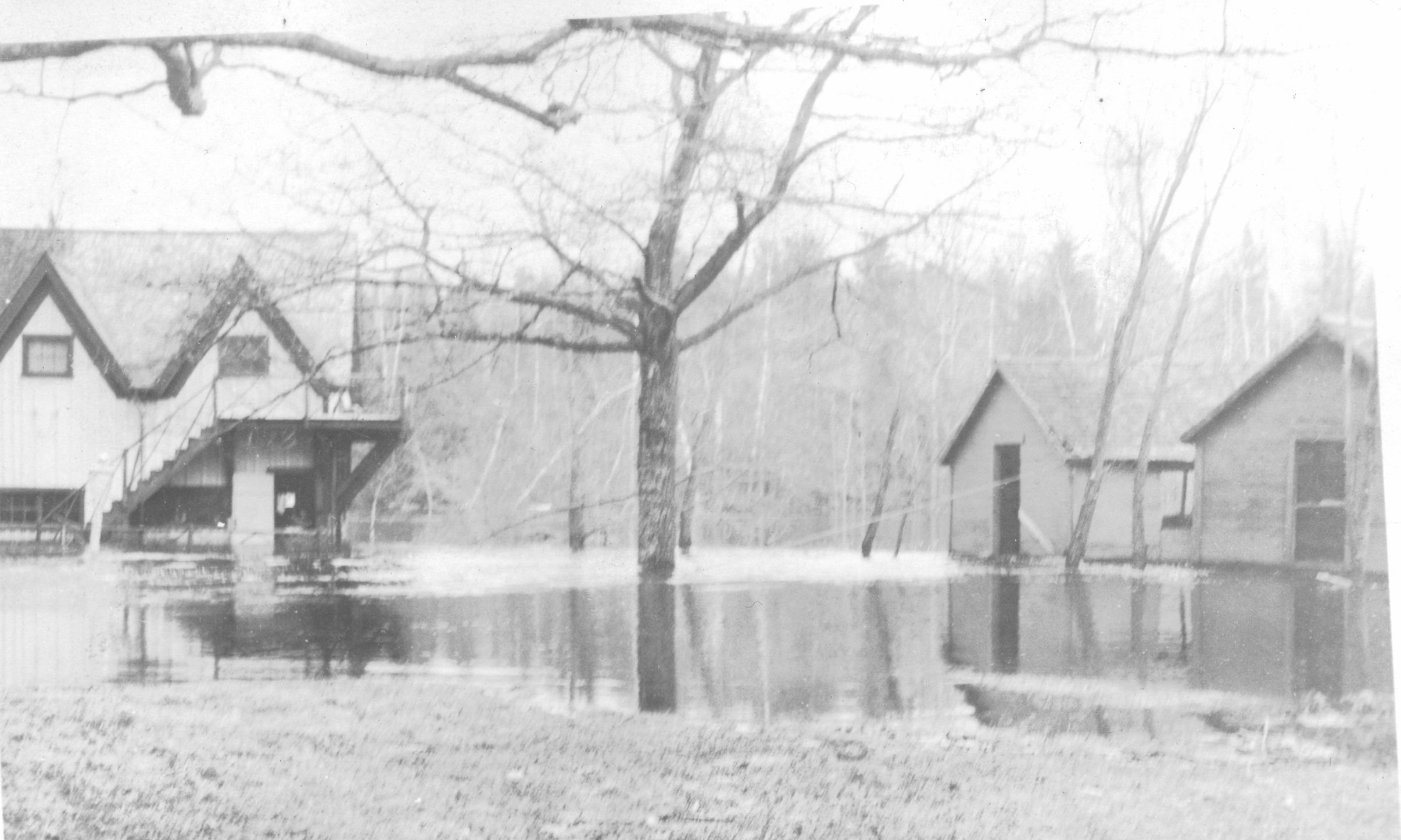
Flood Waters from Main Stream engulf the Castle Harmony Boat House
*
Electricity finally arrived at Castle Harmony around 1920 and with it brighter lighting for the traditional poker games in the library at the long standing famous poker table pictured here in February of 1921.
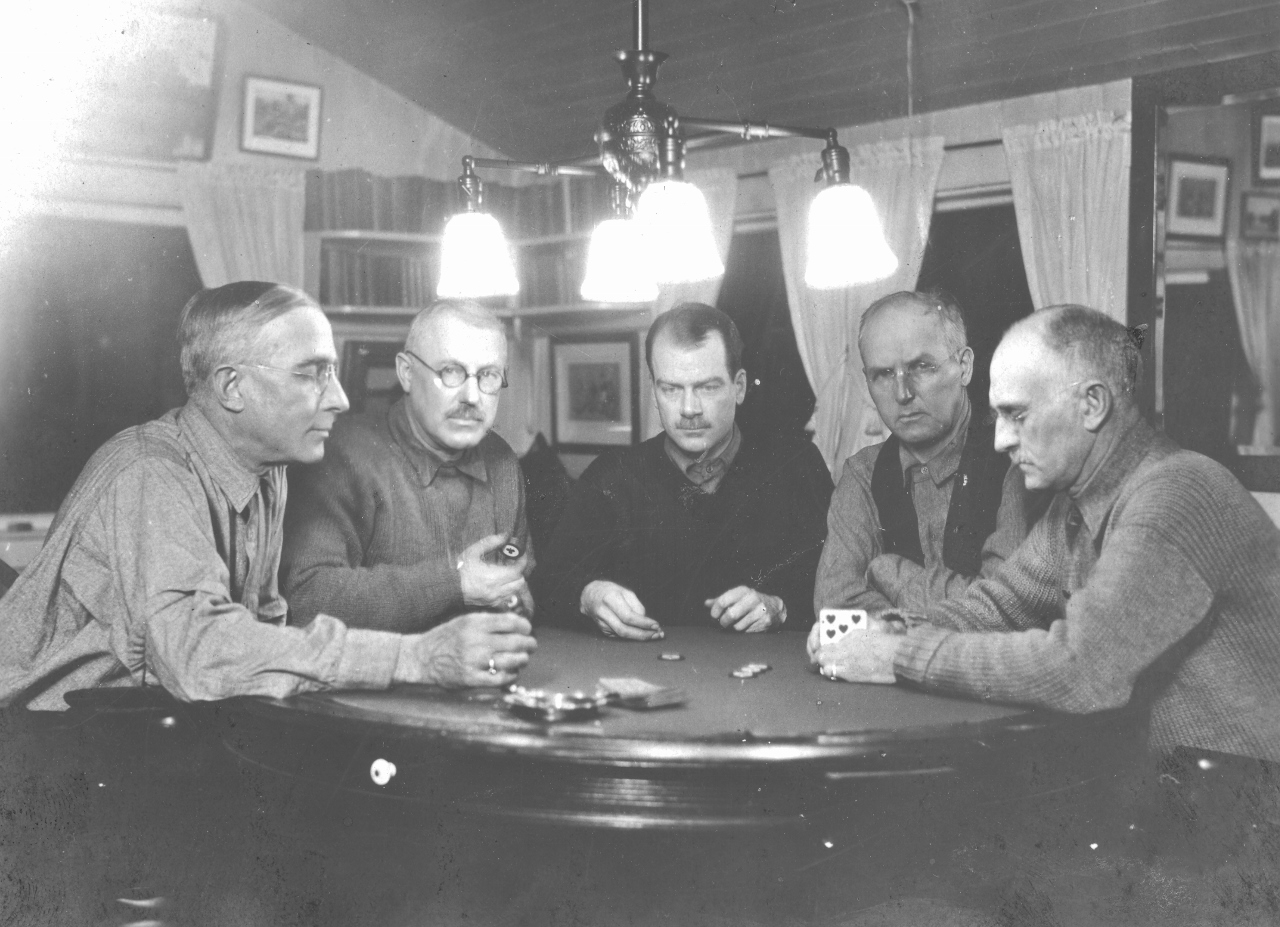
(L-R) Arthur Boardman | J. W. May | I. F. Marshall | Dr. C. B. R. Chase | Ralph L. Hall
*
Over the decades of their respective existences, dozens of area locals were employed by The Wild Goose Club & The Commodore Club including caretakers, cooks, maids, waitresses, groundskeepers, drivers, maintenance & repairmen and private guides among other services.
Both clubs also relied on local merchants to provide them with foods and supplies. These merchants, including many from Harmony and Hartland, received a welcomed boost to their sales when club members & guests arrived for their annual wilderness adventures. Many of them delivered their goods directly to the respective lodges.
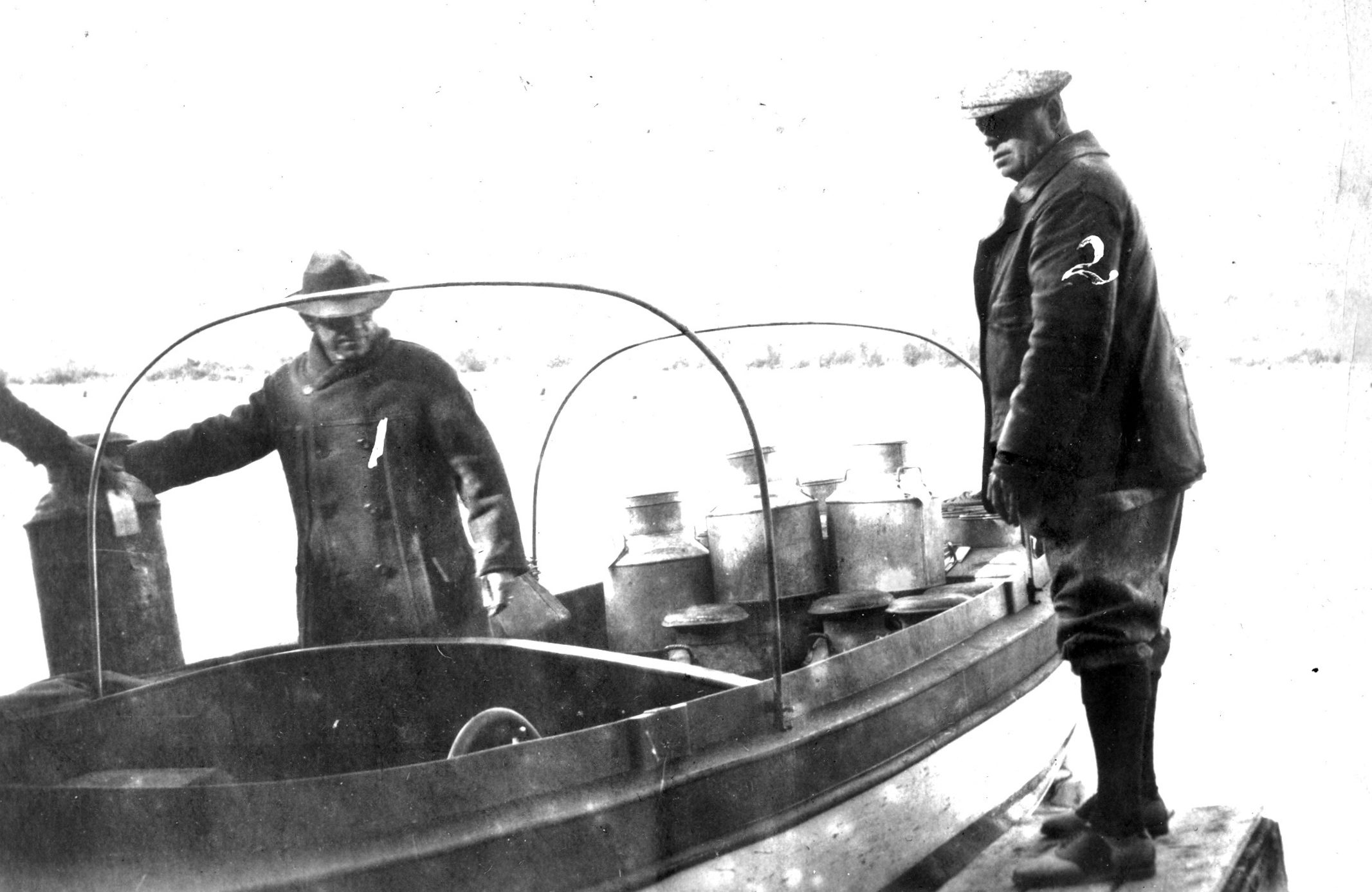
1. George Merrill Lancey & 2. T. A. Appollonio making a delivery of supplies to The Wild Goose Club in 1922
*
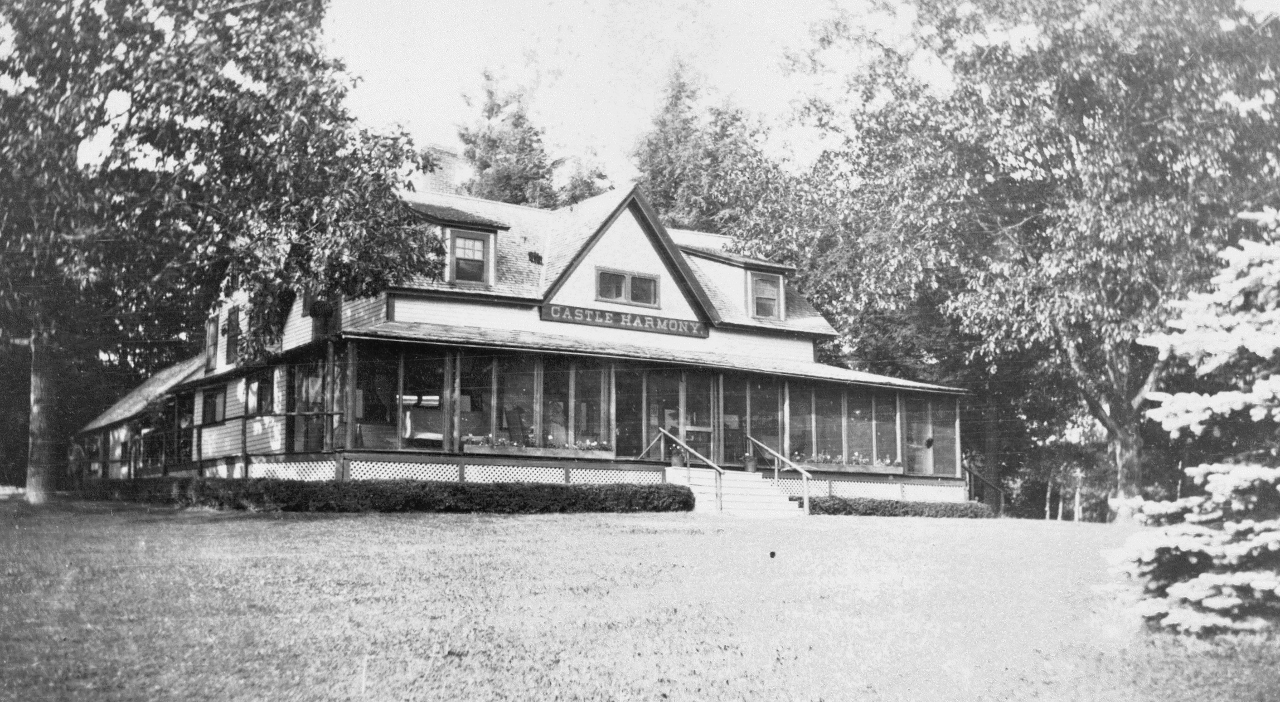
Castle Harmony Main Lodge
*
The Wild Goose Club came to an abrupt end in 1933 at the height of the Great Depression when many of its members could no longer justify or afford the expense. Ownership of Castle Harmony was left to W. L. Hayward, said to be the last surviving active Wild Goose Club Member. Upon his death, his son Bill Hayward inherited the Castle Harmony property until he sold it to Mr. & Mrs. Hayward around 1948. The Haywards (no relation to Bill) spent several summers at Castle Harmony with their daughter Dorothy (Hayward) Wood until they sold it to Mr. & Mrs. Trauth in 1955.
*
A 1954 article written while Mr. & Mrs. Hayward owned the property provided numerous details of the legacy of Castle Harmony.
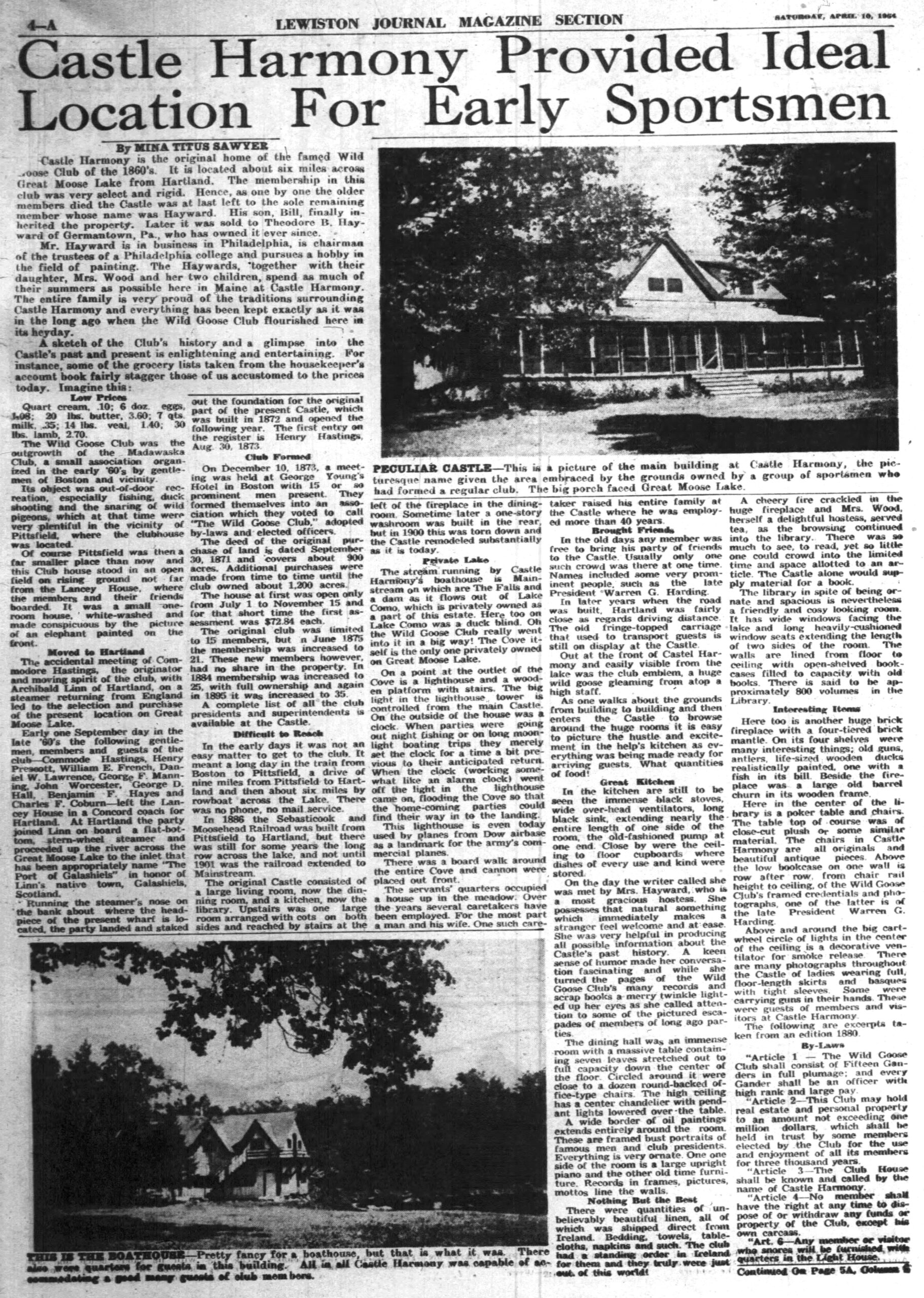

Lewiston Journal – Published April 10, 1954
*
The year after Bill & Lorna Trauth’s purchase of Castle Harmony, an article about their newly opened boys camp began with another insightful look at The Wild Goose Club’s history with many of the details included in our story above.
*
“The Wild Goose Club at Castle Harmony”
From Little Talks Magazine – 1956
“The Wild Goose Club was an organization of Massachusetts business and professional men, which had its location in our part of Maine and continued its exotic gatherings for 85 years. In the year 1862, when the Civil War had barely started, a group of fifteen gentlemen of Boston and vicinity organized the Madawaska Club, with its location at Pittsfield, Maine.
The object was out-of-door recreation, especially fishing, duck hunting, and the snaring of wild pigeons. Pittsfield was selected because it was the largest town in the area of all New England that was most famous for its annual fall flights of wild pigeons in the middle of the 19th century.
Furthermore, Pittsfield had a well known hotel, the Lancey House. The organization took over a building and converted it into a club house, with living room and kitchen on the lower floor and one big dormitory room with cots occupying all of the second story. The club house stood in an open field near the Lancey House, where the members got their meals. On the front of the club house was a large painting of an elephant, which ever after became the symbol of the club, as it has since become the symbol of a national political party.
The founder and leading spirit was Henry Hastings of Boston, who was the club’s first president or, as he was called, “The Commodore”. By 1862 the railroad had reached Pittsfield. Members would charter a sleeping car and make the trip to Pittsfield in July. A few, who were retired from active business, remained all summer and well into the fall. Others came for shorter visits. All put in a lot of time fishing, and when September came, duck hunting and pigeon snaring were the principal sports.
In 1866, on a steamer returning from England, Henry Hastings met Archibald Linn of Hartland, who was coming home from a visit to his native Scotland. Linn sang the praises of the country around Great Moose Lake or, as he probably called it, Moose Pond. As a result in September of that year nine members of the Madawaska Club left the Lancey House in a Concord coach.
At Hartland, joined by Linn, they boarded a flat-bottomed, stern-wheeled steamer and proceeded up the river and across the lake to the inlet that they named the “Port of Galashiels” in honor of Linn’s native town in Scotland. The party landed and staked out a location for the club, having decided to move it from Pittsfield village right out into the country, where hunting and fishing were at the very door. There in 1872 they erected a club house, to which they gave the name “Castle Harmony” – doubly appropriate, because it lay in the town of Harmony, and the word applied to a group of congenial fellows getting recreation together.
There, through the years, the members developed their 900 acres, erected three other buildings, and annually brought hundreds of personal guests. The club membership, in its whole 85 years, never exceeded 35, but many members would entertain as many as 20 guests a piece during the long season from mid July to late October.
At a meeting in Young’s Hotel in Boston in December of 1873, the members decided to rename the club the “Wild Goose Club”. In the early days it was a hard place to reach. A long train trip from Boston to Pittsfield was followed by a buckboard ride of nine miles to Hartland, then six miles by row boat to their club site across the lake. There was no telephone, and the only way to get mail was to go to Hartland for it.
In 1886 the Sebasticook and Moosehead Railroad was extended from Pittsfield to Hartland. But it was not until 1901, when the line was extended to Mainstream that the club had a siding put in near its camp, so that the club Pullman car from Boston could be put on that siding and stay right there until members wanted to use it to return to the Hub. In the last 45 years of its existence the members could go from Boston almost to the gates of their camp by rail.
The members of the Wild Goose Club, who called themselves “ganders”, would find quite a different population now inhabiting their camp – a lively, jolly, but very gentlemanly group of 30 young goslings under the charge of a New York school teacher named William Trauth, Sr. For where the old gentlemen from Boston once snared the now extinct wild pigeon is one of the finest and most carefully conducted boys’ camps in Maine – Mr. Trauth’s Wild Goose Camp for Boys.
Just a little more than a month ago I had the pleasure of visiting the camp, and had lunch with William and his wife, Lorna Trauth, their counselors and all the boys except those who were away on an over-night canoe trip. I was struck by the seemingly casual and flexible, yet actually carefully planned organization of the camp. Nowhere have I ever seen such uniformly good manners, natural and not obviously artificial, in a group of youngsters aged 8 to 13 – usually the most boisterous and unmannerly of ages. I suspect Wild Goose Camp today is much more quiet and orderly than was its predecessor, the Wild Goose Club, and I am sure it serves a much better purpose.
Mr. Trauth has carefully preserved the portraits, the albums, and the records of the old club, which were carelessly left on the premises when the property was sold by the sons and grandsons of old members, for the younger generation of those visiting Bostonians just didn’t care what happened to the old club. But Mr. Trauth has an eye for historic lore, and thanks to him we can today get a glimpse of how those Bostonians of the 1870′s spent their time in the Maine woods.
For one thing they got thirsty. On August 20, 1865, when their club house was still at Pittsfield, the founder Henry Hastings wrote a letter to General Samuel Lawrence at Medford, Mass. Hastings wrote: “Seven of us are languishing for that distilled aqua which was originally discovered by one of your ancestors, famous for its strengthening and invigorating qualities, called Old Medford Rum. I will forgive you all your faults if you will ship by the Eastern Express Company one five gallon keg of the oldest vintage to the Madawaska Club, Pittsfield, Maine.”
General Lawrence replied: “Dear General Hastings. Per your serious appeal for the Seven sons of Medford desperately dry. Since I cannot accept your invitation and come personally to your relief, I will content myself by sending five gallons of proxy.”
Most of us are familiar with the sad story of the American wild pigeon. When our Maine people with itching feet sought new homes in the prairie states in the 1840′s and 1850′s, they recorded the almost unbelievable size of the pigeon flights. The slaughter of the birds was wanton, heedless and often useless. Glutted markets could not absorb the killed birds, and thousands were left to rot on the ground. The ruthless slaughter finally brought an end to the whole species, so that today not a single wild pigeon remains.
The members of the Wild Goose Club did not shoot the pigeons. They snared them in huge nets. And what hauls they got! In 1865 their catch was 1,920 birds; in 1866 it had risen to 3,490, which proved to be the peak; but for several years afterward the annual take exceeded 2,000. Compare those figures with the shooting of ducks. The largest recorded kill was in 1865, when the total reached 280. In 1866 it dropped slightly to 210, and in 1867 sharply to 166; and in 1870, when they netted 1,864 pigeons, they shot only 42 ducks. In the club records we note entries like these: “Caught at St. Albans 51 pigeons; got at Gressy Isle 26 ducks; caught 79 pigeons at Uncle Josh’s; got at Douglas’ 42 ducks, 24 of them cockaloroms of grand style.”
The Wild Goose Club got more pigeons and ducks than they could use. On September 5, 1866 their journal records that they caught 105 pigeons, but were nearly devoured by mosquitoes. Then the next day they sent 15 dozen pigeons to market, noting that on the same day there was both a grand Sabbath School picnic and a circus at Hartland.
The records contain a number of humorous incidents. In September, 1867 the members had so many guests with them in Pittsfield that the Lancey House was filled to capacity, as well as the club dormitory. A group of members, returning from a late evening out, saw a buggy at the hotel door. From it stepped a gentleman, who gave his hand to a female companion, who entered the parlor with her head heavily veiled. The landlord was summoned from bed. He informed the couple that he could not accommodate them because the house was full.
But the club members were too humane to turn a female out of doors at that hour of the night and into the chilly autumn air. The kind hearted Commodore Hastings informed the pair that they could have his room, but that to reach it, they would have to go through a room where two of his guests had already retired. Reluctantly the couple accepted and the two male guests were ordered to draw their heads under the bed clothes while the woman passed through. With face still covered, she crossed the room and found refuge with her companion in the Commodore‘s quarters. The next morning the pair departed with the woman still heavily veiled. Shortly afterward, when a deputy sheriff arrived, the gallant club members learned that they had given refuge to a woman running away from her husband with another man.
Another incident concerns a local character called Uncle John Pigeon. One day the old fellow came to the club saying he was out of bait. The bait he sought proved to be a bottle of Hostetter’s Bitters, but he settled for a bottle of Wahoo Bitters, which perhaps had just as much kick as Hostetter’s. An interesting coincidence is that this summer in Wild Goose Camp was a boy named Webster, who is great-grandson of one of the charter members of the famous Wild Goose Club, who snared pigeons and drank Old Medford Rum on the same spot long, long ago.”
This poem was hung in a gold frame at the entrance of the Castle Harmony Main Lodge:
“Here on the shores of this wild lovely lake
Where nature all her prospects richly blend,
Has met for years (What memories awake!)
A choice Companionship of genial friends”
*
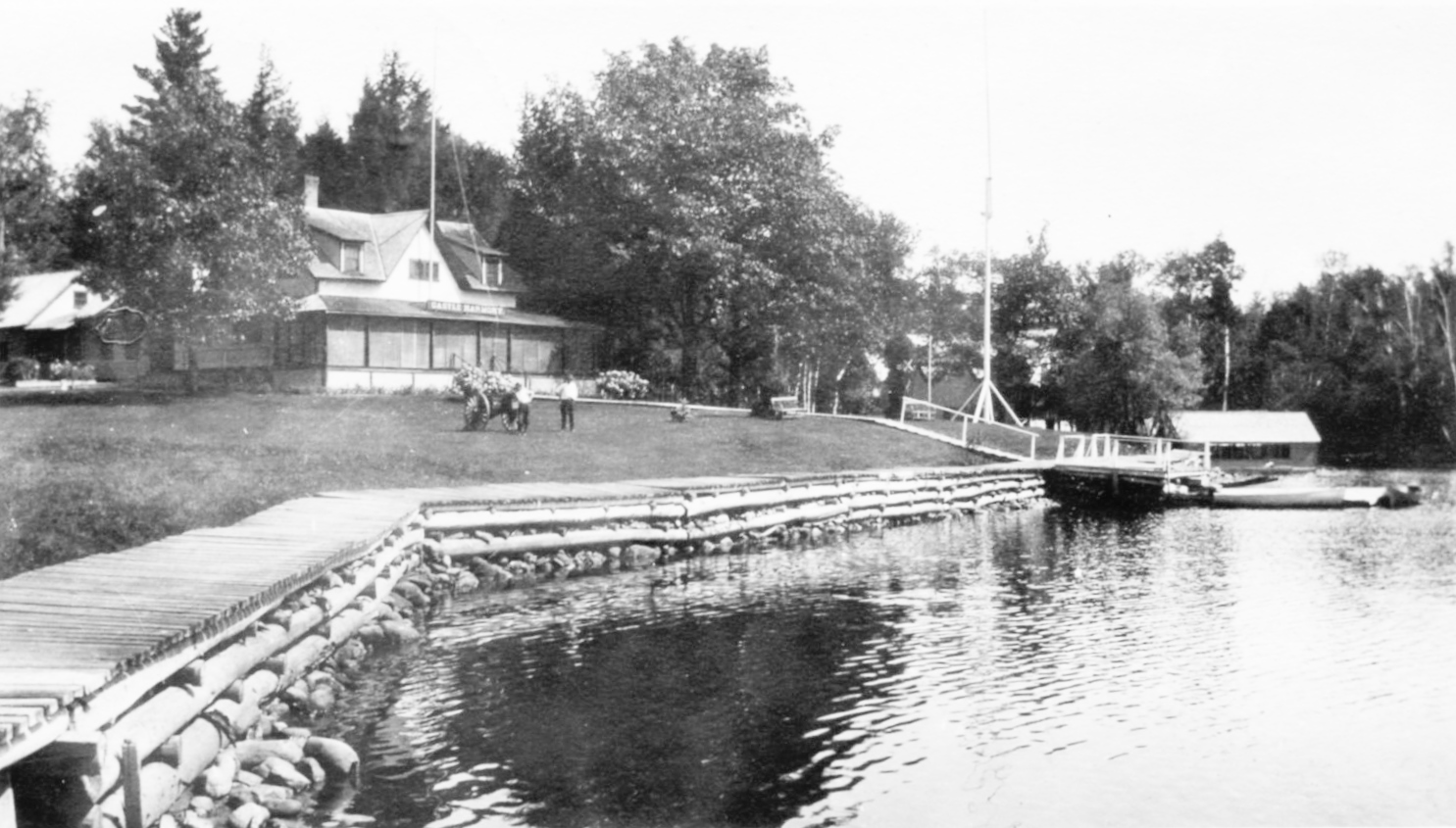
Castle Harmony
*
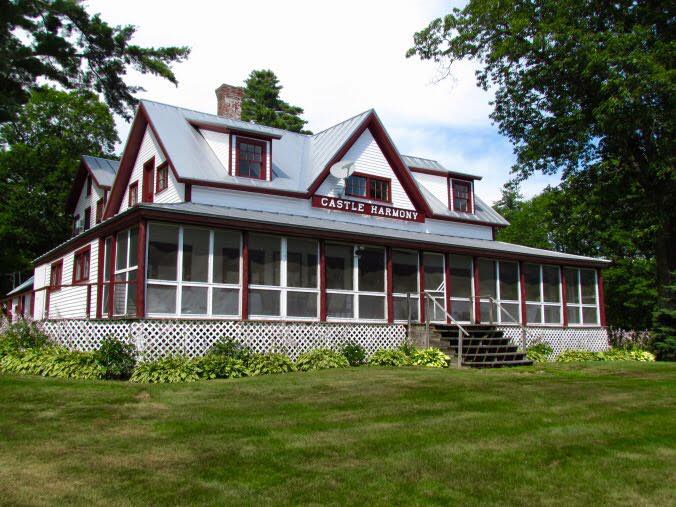
Undated Modern Photo of Castle Harmony Main Lodge
*
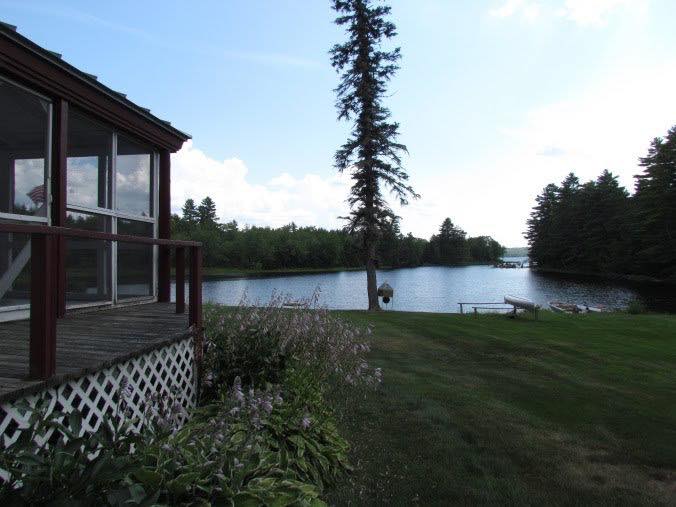
Modern view from Castle Harmony Main Lodge looking across Main Stream onto Great Moose Lake
*
Following the death of Col. Henry Hastings in February of 1917, interest in continuing The Commodore Club appears to have dramatically declined so much so that within a couple of years, The Commodore Club Lodge was sold at auction to Frank A. Sayles of Pawtucket, Rhode Island. In late 1922, Elliott L. MacDonald, President of the L. B. Southwick Tanning Company of Peabody, Massachusetts purchased the property and began extensive repairs on the lodge and its landscape as reported in a November 23, 1922 Independent Reporter article. Mr. MacDonald reopened the lodge as a seasonal vacation destination mostly for the private use of family & friends from Massachusetts but eventually also offered fine dining opened seasonally to area residents.
In 1937, the former Commodore Club Lodge was purchased by Edward Cudihy, Raymond Heffernan & John McHugh. Mr. McHugh soon sold his interest but Mr. & Mrs. Cudihy and Mr. & Mrs. Heffernan continued their shared ownership for the next 30+ years and retained the original Commodore Club name for the lodge. Both couples hosted numerous vacationing family members & friends, mostly from Massachusetts, over the years and on some special occasions upwards of 50 to 75 guests were reported to have stayed at the lodge. To accommodate their many guests, private cooks were employed and local high school girls, many from Hartland, were hired to work as kitchen help, waitresses and maids during the summer as well as employing year round caretakers. During the years they spent there, the Heffernans contributed generously to various fund raising efforts in Hartland including donations toward new equipment for the Hartland Volunteer Fire Department & Scott-Webb Memorial Hospital. Mr. Heffernan passed away in 1973 and Mr. Cudihy in 1978 and The Commodore Club Lodge was eventually sold. It still stands today under private ownership along the shores of Great Moose Lake.
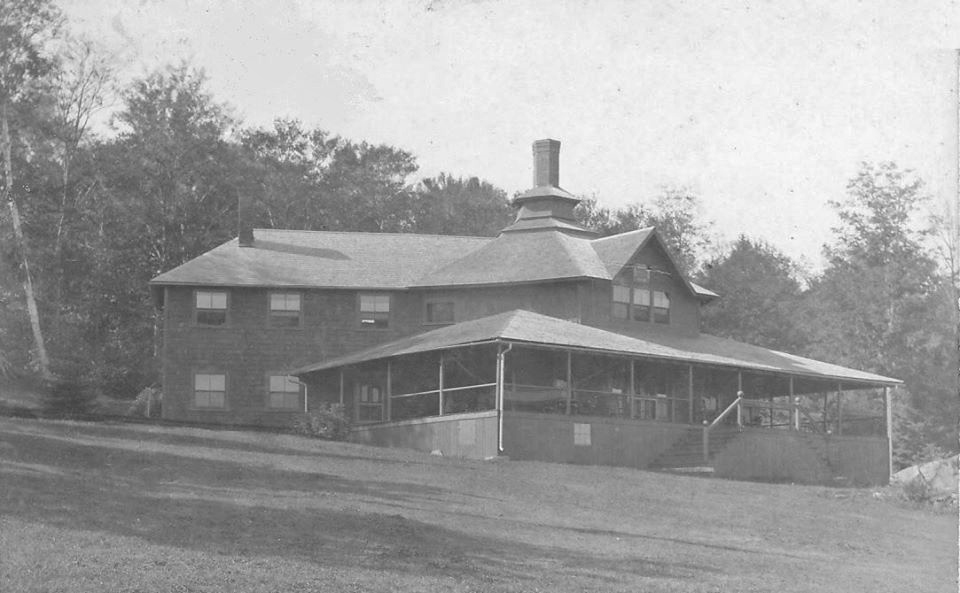
The Commodore Club Lodge
*
Although The Wild Goose Club ultimately faltered, its spirit of adventure and camaraderie would be reignited at Castle Harmony in 1955 when a former New York school teacher and his wife purchased the property and opened the Wild Goose Camp for Boys the following year.